Analysis of Entrepreneurial Behavior and Performance
VerifiedAdded on 2020/07/22
|32
|4174
|61
AI Summary
The provided document is an extensive compilation of academic papers and research studies related to entrepreneurial behavior and performance. It includes 11 references from 2013 to 2017, covering topics such as management education, pricing strategies, and international financial statement analysis. The assignment aims to analyze the factors that influence business success and provide insights into strategies for improvement.
Contribute Materials
Your contribution can guide someone’s learning journey. Share your
documents today.

Business Analysis Project
Secure Best Marks with AI Grader
Need help grading? Try our AI Grader for instant feedback on your assignments.
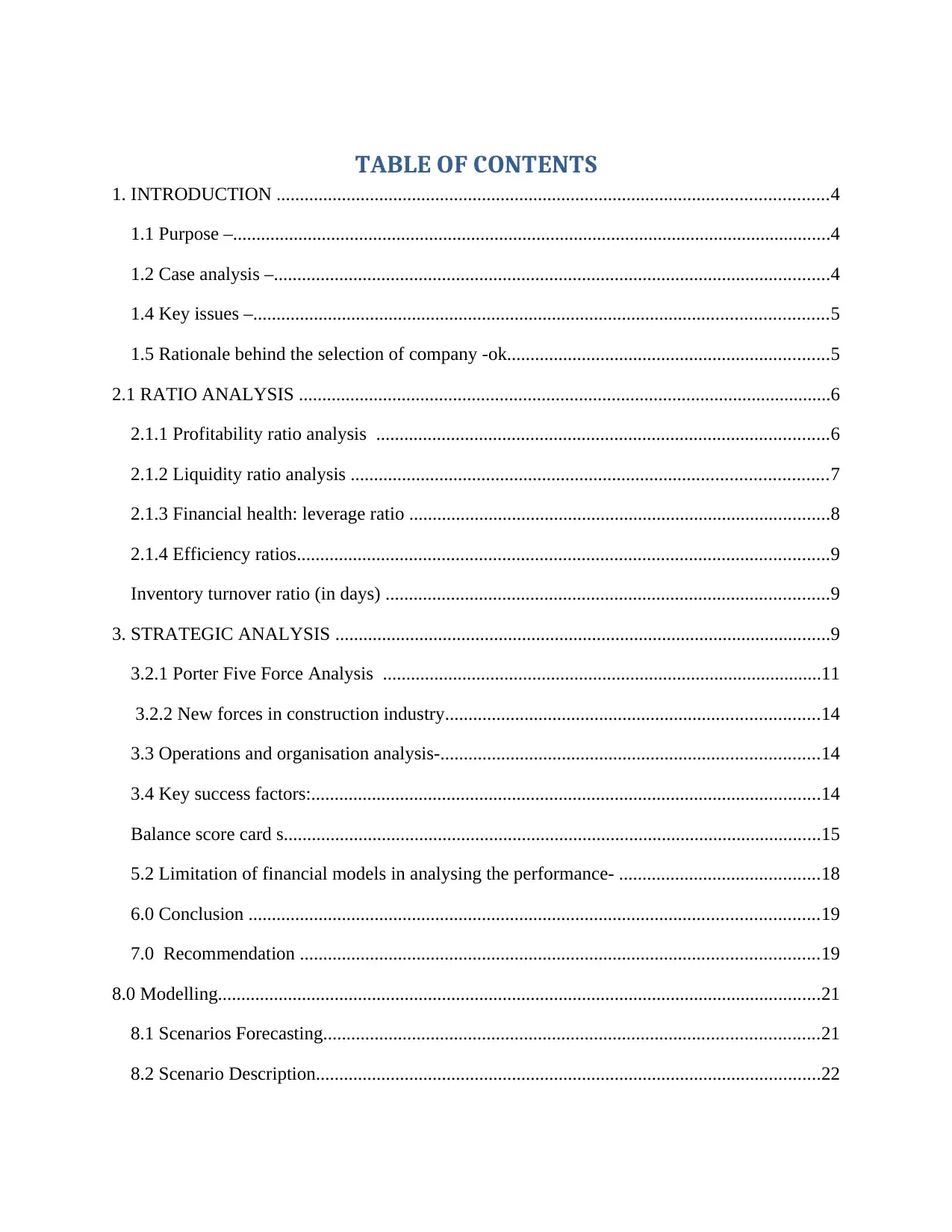
TABLE OF CONTENTS
1. INTRODUCTION ......................................................................................................................4
1.1 Purpose –................................................................................................................................4
1.2 Case analysis –.......................................................................................................................4
1.4 Key issues –...........................................................................................................................5
1.5 Rationale behind the selection of company -ok.....................................................................5
2.1 RATIO ANALYSIS ..................................................................................................................6
2.1.1 Profitability ratio analysis .................................................................................................6
2.1.2 Liquidity ratio analysis ......................................................................................................7
2.1.3 Financial health: leverage ratio ..........................................................................................8
2.1.4 Efficiency ratios..................................................................................................................9
Inventory turnover ratio (in days) ...............................................................................................9
3. STRATEGIC ANALYSIS ..........................................................................................................9
3.2.1 Porter Five Force Analysis ..............................................................................................11
3.2.2 New forces in construction industry................................................................................14
3.3 Operations and organisation analysis-.................................................................................14
3.4 Key success factors:.............................................................................................................14
Balance score card s...................................................................................................................15
5.2 Limitation of financial models in analysing the performance- ...........................................18
6.0 Conclusion ..........................................................................................................................19
7.0 Recommendation ...............................................................................................................19
8.0 Modelling.................................................................................................................................21
8.1 Scenarios Forecasting..........................................................................................................21
8.2 Scenario Description............................................................................................................22
1. INTRODUCTION ......................................................................................................................4
1.1 Purpose –................................................................................................................................4
1.2 Case analysis –.......................................................................................................................4
1.4 Key issues –...........................................................................................................................5
1.5 Rationale behind the selection of company -ok.....................................................................5
2.1 RATIO ANALYSIS ..................................................................................................................6
2.1.1 Profitability ratio analysis .................................................................................................6
2.1.2 Liquidity ratio analysis ......................................................................................................7
2.1.3 Financial health: leverage ratio ..........................................................................................8
2.1.4 Efficiency ratios..................................................................................................................9
Inventory turnover ratio (in days) ...............................................................................................9
3. STRATEGIC ANALYSIS ..........................................................................................................9
3.2.1 Porter Five Force Analysis ..............................................................................................11
3.2.2 New forces in construction industry................................................................................14
3.3 Operations and organisation analysis-.................................................................................14
3.4 Key success factors:.............................................................................................................14
Balance score card s...................................................................................................................15
5.2 Limitation of financial models in analysing the performance- ...........................................18
6.0 Conclusion ..........................................................................................................................19
7.0 Recommendation ...............................................................................................................19
8.0 Modelling.................................................................................................................................21
8.1 Scenarios Forecasting..........................................................................................................21
8.2 Scenario Description............................................................................................................22
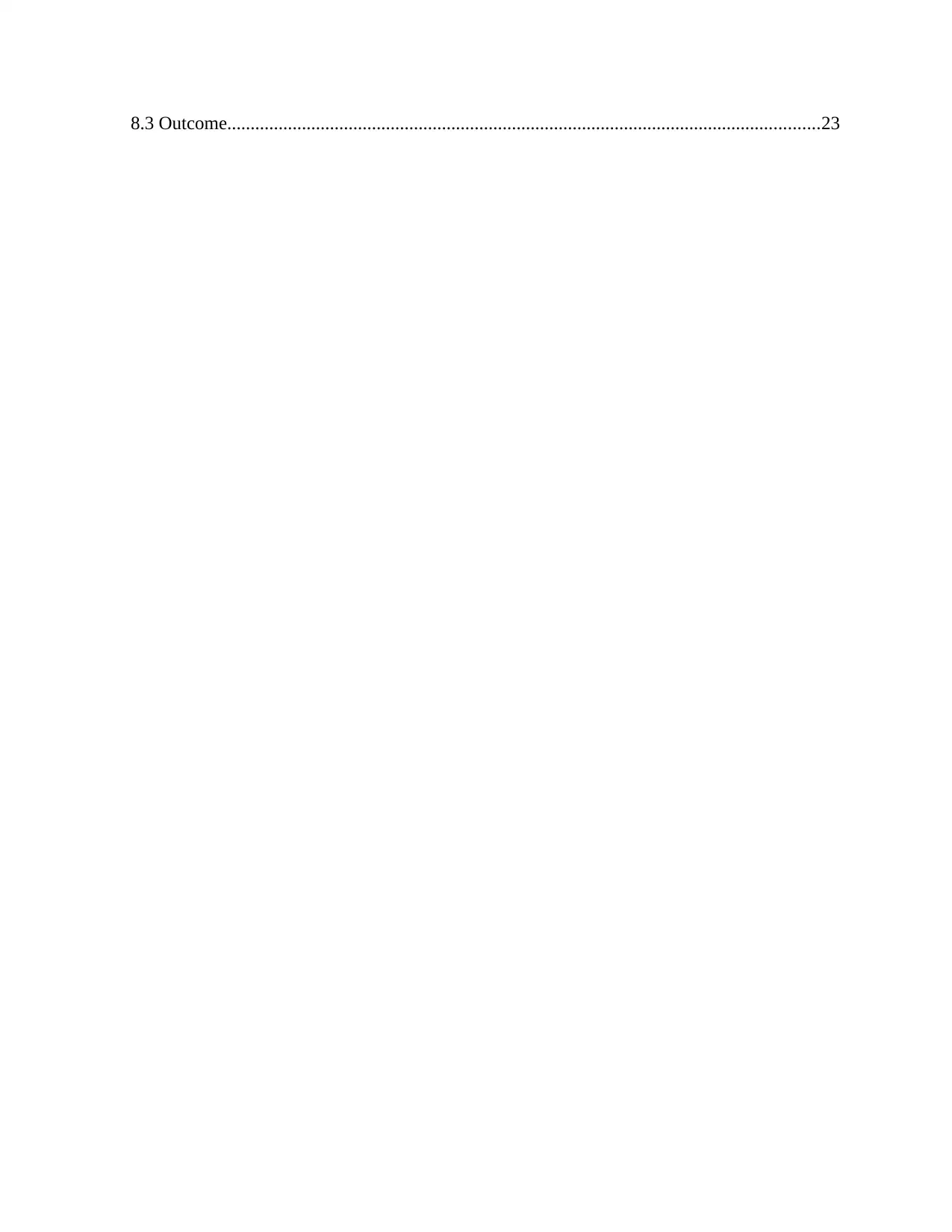
8.3 Outcome...............................................................................................................................23
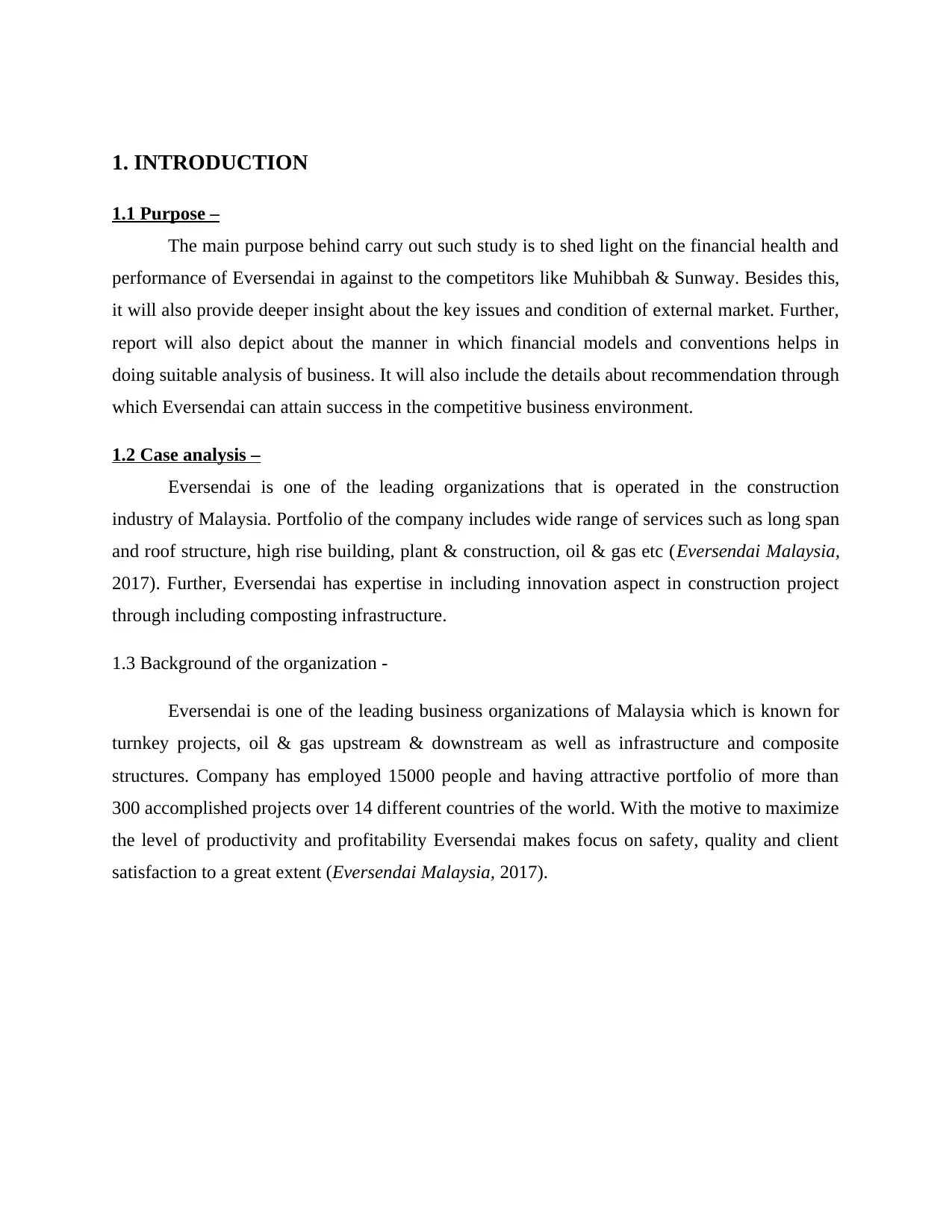
1. INTRODUCTION
1.1 Purpose –
The main purpose behind carry out such study is to shed light on the financial health and
performance of Eversendai in against to the competitors like Muhibbah & Sunway. Besides this,
it will also provide deeper insight about the key issues and condition of external market. Further,
report will also depict about the manner in which financial models and conventions helps in
doing suitable analysis of business. It will also include the details about recommendation through
which Eversendai can attain success in the competitive business environment.
1.2 Case analysis –
Eversendai is one of the leading organizations that is operated in the construction
industry of Malaysia. Portfolio of the company includes wide range of services such as long span
and roof structure, high rise building, plant & construction, oil & gas etc (Eversendai Malaysia,
2017). Further, Eversendai has expertise in including innovation aspect in construction project
through including composting infrastructure.
1.3 Background of the organization -
Eversendai is one of the leading business organizations of Malaysia which is known for
turnkey projects, oil & gas upstream & downstream as well as infrastructure and composite
structures. Company has employed 15000 people and having attractive portfolio of more than
300 accomplished projects over 14 different countries of the world. With the motive to maximize
the level of productivity and profitability Eversendai makes focus on safety, quality and client
satisfaction to a great extent (Eversendai Malaysia, 2017).
1.1 Purpose –
The main purpose behind carry out such study is to shed light on the financial health and
performance of Eversendai in against to the competitors like Muhibbah & Sunway. Besides this,
it will also provide deeper insight about the key issues and condition of external market. Further,
report will also depict about the manner in which financial models and conventions helps in
doing suitable analysis of business. It will also include the details about recommendation through
which Eversendai can attain success in the competitive business environment.
1.2 Case analysis –
Eversendai is one of the leading organizations that is operated in the construction
industry of Malaysia. Portfolio of the company includes wide range of services such as long span
and roof structure, high rise building, plant & construction, oil & gas etc (Eversendai Malaysia,
2017). Further, Eversendai has expertise in including innovation aspect in construction project
through including composting infrastructure.
1.3 Background of the organization -
Eversendai is one of the leading business organizations of Malaysia which is known for
turnkey projects, oil & gas upstream & downstream as well as infrastructure and composite
structures. Company has employed 15000 people and having attractive portfolio of more than
300 accomplished projects over 14 different countries of the world. With the motive to maximize
the level of productivity and profitability Eversendai makes focus on safety, quality and client
satisfaction to a great extent (Eversendai Malaysia, 2017).
Secure Best Marks with AI Grader
Need help grading? Try our AI Grader for instant feedback on your assignments.
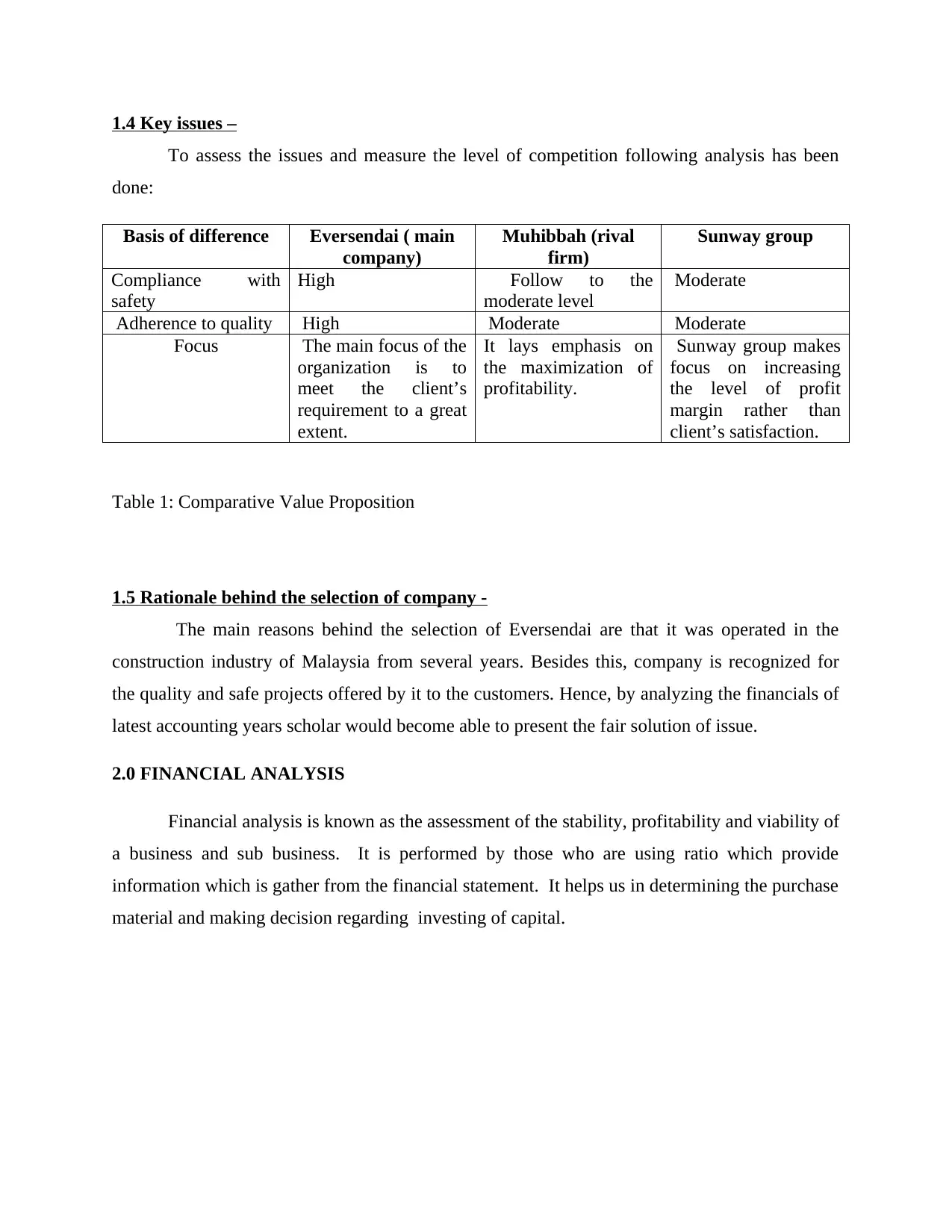
1.4 Key issues –
To assess the issues and measure the level of competition following analysis has been
done:
Basis of difference Eversendai ( main
company)
Muhibbah (rival
firm)
Sunway group
Compliance with
safety
High Follow to the
moderate level
Moderate
Adherence to quality High Moderate Moderate
Focus The main focus of the
organization is to
meet the client’s
requirement to a great
extent.
It lays emphasis on
the maximization of
profitability.
Sunway group makes
focus on increasing
the level of profit
margin rather than
client’s satisfaction.
Table 1: Comparative Value Proposition
1.5 Rationale behind the selection of company -
The main reasons behind the selection of Eversendai are that it was operated in the
construction industry of Malaysia from several years. Besides this, company is recognized for
the quality and safe projects offered by it to the customers. Hence, by analyzing the financials of
latest accounting years scholar would become able to present the fair solution of issue.
2.0 FINANCIAL ANALYSIS
Financial analysis is known as the assessment of the stability, profitability and viability of
a business and sub business. It is performed by those who are using ratio which provide
information which is gather from the financial statement. It helps us in determining the purchase
material and making decision regarding investing of capital.
To assess the issues and measure the level of competition following analysis has been
done:
Basis of difference Eversendai ( main
company)
Muhibbah (rival
firm)
Sunway group
Compliance with
safety
High Follow to the
moderate level
Moderate
Adherence to quality High Moderate Moderate
Focus The main focus of the
organization is to
meet the client’s
requirement to a great
extent.
It lays emphasis on
the maximization of
profitability.
Sunway group makes
focus on increasing
the level of profit
margin rather than
client’s satisfaction.
Table 1: Comparative Value Proposition
1.5 Rationale behind the selection of company -
The main reasons behind the selection of Eversendai are that it was operated in the
construction industry of Malaysia from several years. Besides this, company is recognized for
the quality and safe projects offered by it to the customers. Hence, by analyzing the financials of
latest accounting years scholar would become able to present the fair solution of issue.
2.0 FINANCIAL ANALYSIS
Financial analysis is known as the assessment of the stability, profitability and viability of
a business and sub business. It is performed by those who are using ratio which provide
information which is gather from the financial statement. It helps us in determining the purchase
material and making decision regarding investing of capital.
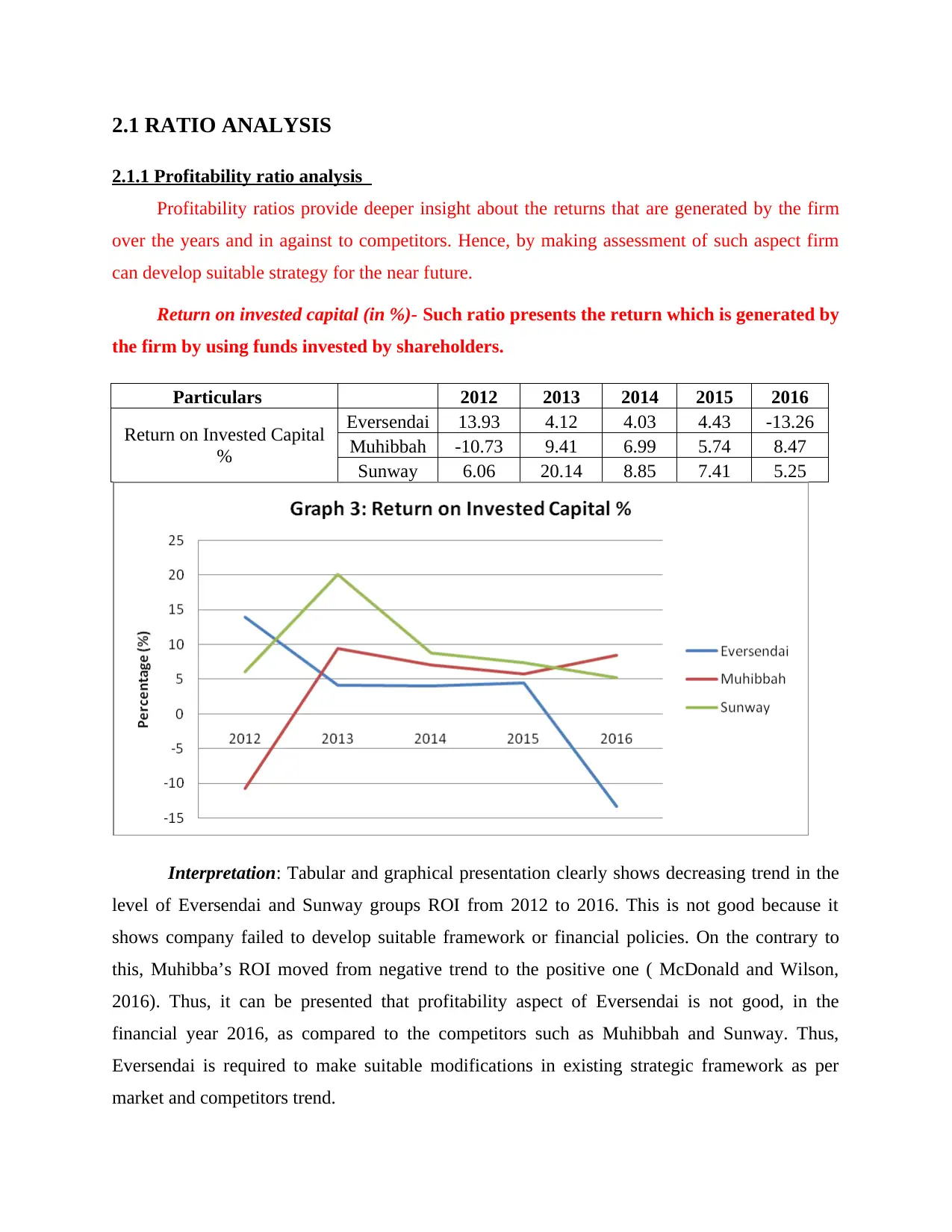
2.1 RATIO ANALYSIS
2.1.1 Profitability ratio analysis
Profitability ratios provide deeper insight about the returns that are generated by the firm
over the years and in against to competitors. Hence, by making assessment of such aspect firm
can develop suitable strategy for the near future.
Return on invested capital (in %)- Such ratio presents the return which is generated by
the firm by using funds invested by shareholders.
Particulars 2012 2013 2014 2015 2016
Return on Invested Capital
%
Eversendai 13.93 4.12 4.03 4.43 -13.26
Muhibbah -10.73 9.41 6.99 5.74 8.47
Sunway 6.06 20.14 8.85 7.41 5.25
Interpretation: Tabular and graphical presentation clearly shows decreasing trend in the
level of Eversendai and Sunway groups ROI from 2012 to 2016. This is not good because it
shows company failed to develop suitable framework or financial policies. On the contrary to
this, Muhibba’s ROI moved from negative trend to the positive one ( McDonald and Wilson,
2016). Thus, it can be presented that profitability aspect of Eversendai is not good, in the
financial year 2016, as compared to the competitors such as Muhibbah and Sunway. Thus,
Eversendai is required to make suitable modifications in existing strategic framework as per
market and competitors trend.
2.1.1 Profitability ratio analysis
Profitability ratios provide deeper insight about the returns that are generated by the firm
over the years and in against to competitors. Hence, by making assessment of such aspect firm
can develop suitable strategy for the near future.
Return on invested capital (in %)- Such ratio presents the return which is generated by
the firm by using funds invested by shareholders.
Particulars 2012 2013 2014 2015 2016
Return on Invested Capital
%
Eversendai 13.93 4.12 4.03 4.43 -13.26
Muhibbah -10.73 9.41 6.99 5.74 8.47
Sunway 6.06 20.14 8.85 7.41 5.25
Interpretation: Tabular and graphical presentation clearly shows decreasing trend in the
level of Eversendai and Sunway groups ROI from 2012 to 2016. This is not good because it
shows company failed to develop suitable framework or financial policies. On the contrary to
this, Muhibba’s ROI moved from negative trend to the positive one ( McDonald and Wilson,
2016). Thus, it can be presented that profitability aspect of Eversendai is not good, in the
financial year 2016, as compared to the competitors such as Muhibbah and Sunway. Thus,
Eversendai is required to make suitable modifications in existing strategic framework as per
market and competitors trend.
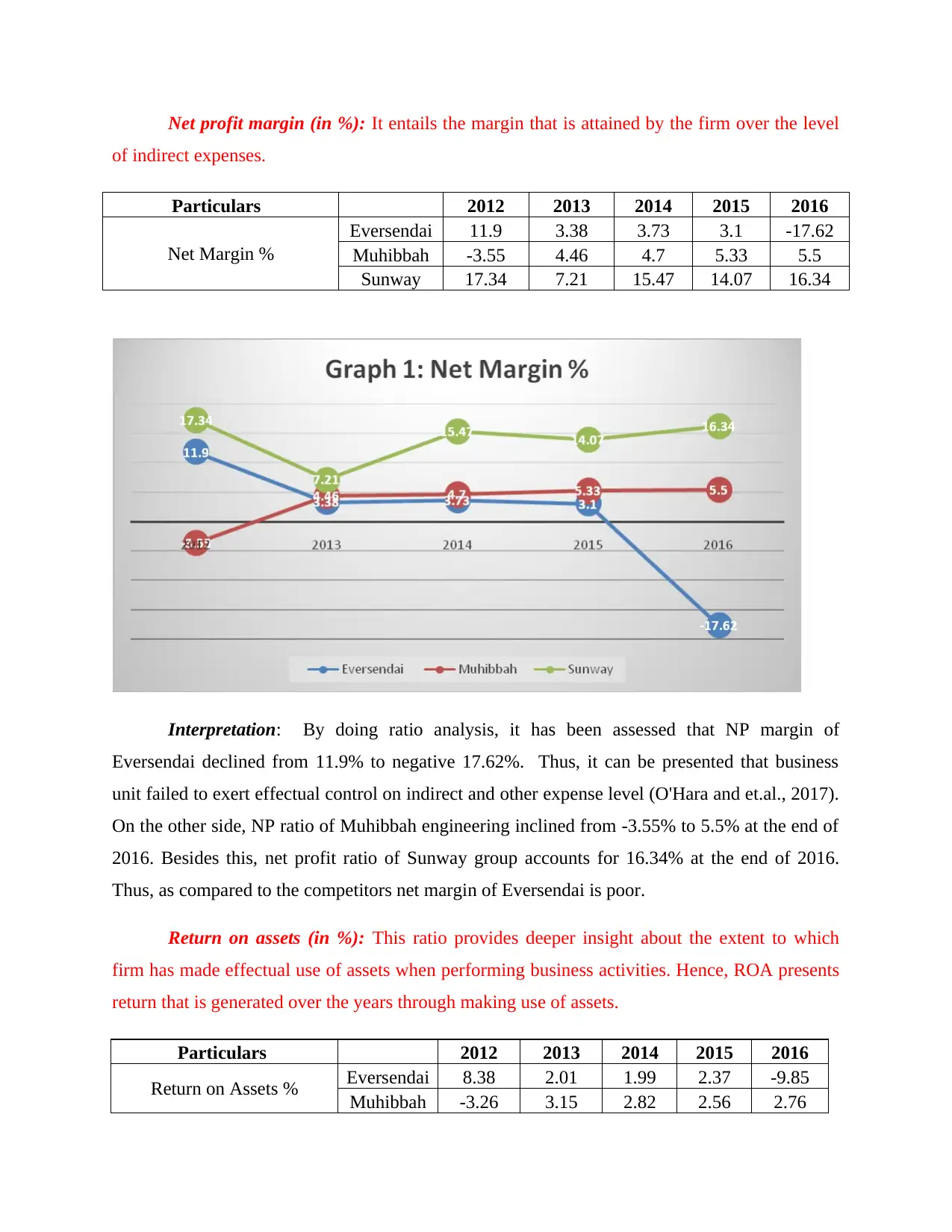
Net profit margin (in %): It entails the margin that is attained by the firm over the level
of indirect expenses.
Particulars 2012 2013 2014 2015 2016
Net Margin %
Eversendai 11.9 3.38 3.73 3.1 -17.62
Muhibbah -3.55 4.46 4.7 5.33 5.5
Sunway 17.34 7.21 15.47 14.07 16.34
Interpretation: By doing ratio analysis, it has been assessed that NP margin of
Eversendai declined from 11.9% to negative 17.62%. Thus, it can be presented that business
unit failed to exert effectual control on indirect and other expense level (O'Hara and et.al., 2017).
On the other side, NP ratio of Muhibbah engineering inclined from -3.55% to 5.5% at the end of
2016. Besides this, net profit ratio of Sunway group accounts for 16.34% at the end of 2016.
Thus, as compared to the competitors net margin of Eversendai is poor.
Return on assets (in %): This ratio provides deeper insight about the extent to which
firm has made effectual use of assets when performing business activities. Hence, ROA presents
return that is generated over the years through making use of assets.
Particulars 2012 2013 2014 2015 2016
Return on Assets % Eversendai 8.38 2.01 1.99 2.37 -9.85
Muhibbah -3.26 3.15 2.82 2.56 2.76
of indirect expenses.
Particulars 2012 2013 2014 2015 2016
Net Margin %
Eversendai 11.9 3.38 3.73 3.1 -17.62
Muhibbah -3.55 4.46 4.7 5.33 5.5
Sunway 17.34 7.21 15.47 14.07 16.34
Interpretation: By doing ratio analysis, it has been assessed that NP margin of
Eversendai declined from 11.9% to negative 17.62%. Thus, it can be presented that business
unit failed to exert effectual control on indirect and other expense level (O'Hara and et.al., 2017).
On the other side, NP ratio of Muhibbah engineering inclined from -3.55% to 5.5% at the end of
2016. Besides this, net profit ratio of Sunway group accounts for 16.34% at the end of 2016.
Thus, as compared to the competitors net margin of Eversendai is poor.
Return on assets (in %): This ratio provides deeper insight about the extent to which
firm has made effectual use of assets when performing business activities. Hence, ROA presents
return that is generated over the years through making use of assets.
Particulars 2012 2013 2014 2015 2016
Return on Assets % Eversendai 8.38 2.01 1.99 2.37 -9.85
Muhibbah -3.26 3.15 2.82 2.56 2.76
Paraphrase This Document
Need a fresh take? Get an instant paraphrase of this document with our AI Paraphraser
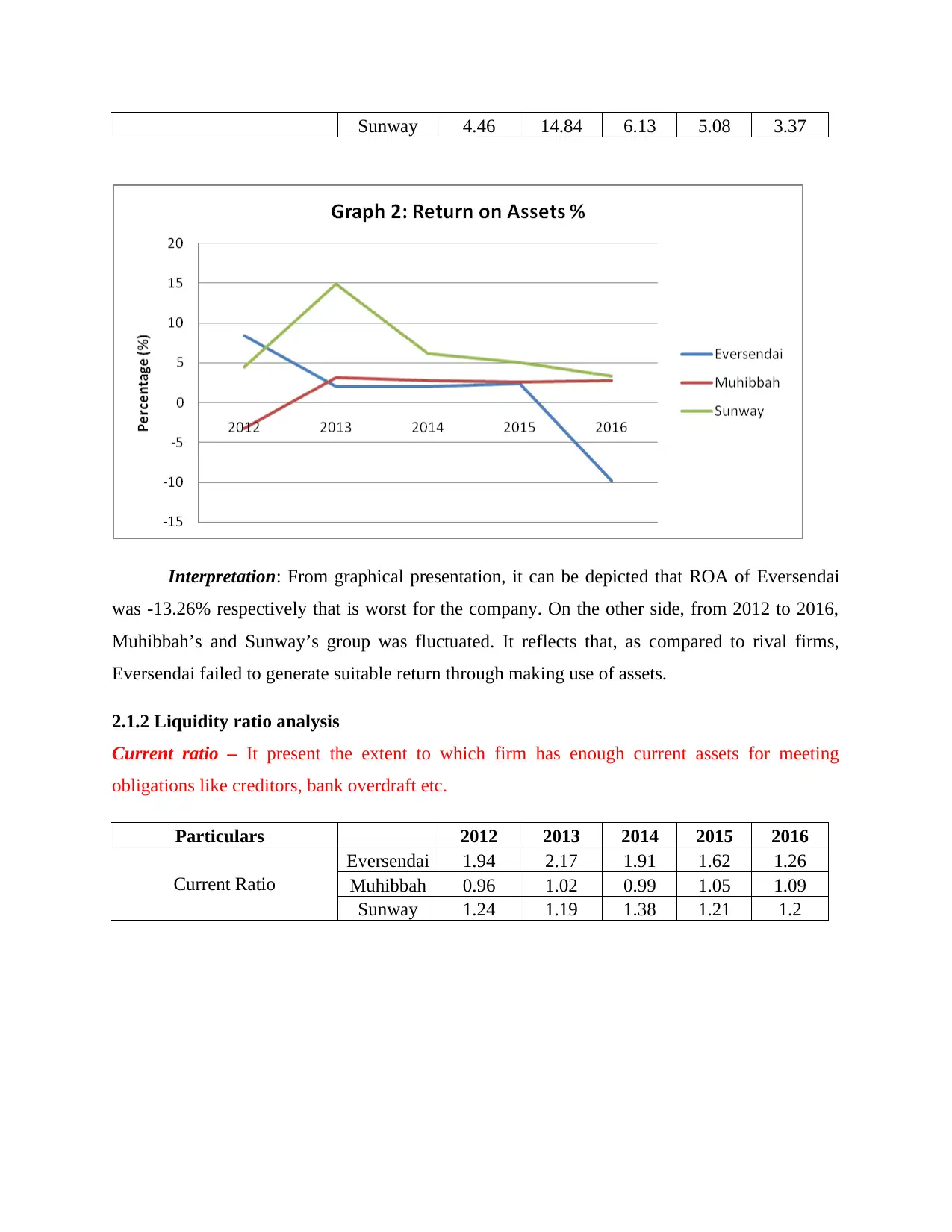
Sunway 4.46 14.84 6.13 5.08 3.37
Interpretation: From graphical presentation, it can be depicted that ROA of Eversendai
was -13.26% respectively that is worst for the company. On the other side, from 2012 to 2016,
Muhibbah’s and Sunway’s group was fluctuated. It reflects that, as compared to rival firms,
Eversendai failed to generate suitable return through making use of assets.
2.1.2 Liquidity ratio analysis
Current ratio – It present the extent to which firm has enough current assets for meeting
obligations like creditors, bank overdraft etc.
Particulars 2012 2013 2014 2015 2016
Current Ratio
Eversendai 1.94 2.17 1.91 1.62 1.26
Muhibbah 0.96 1.02 0.99 1.05 1.09
Sunway 1.24 1.19 1.38 1.21 1.2
Interpretation: From graphical presentation, it can be depicted that ROA of Eversendai
was -13.26% respectively that is worst for the company. On the other side, from 2012 to 2016,
Muhibbah’s and Sunway’s group was fluctuated. It reflects that, as compared to rival firms,
Eversendai failed to generate suitable return through making use of assets.
2.1.2 Liquidity ratio analysis
Current ratio – It present the extent to which firm has enough current assets for meeting
obligations like creditors, bank overdraft etc.
Particulars 2012 2013 2014 2015 2016
Current Ratio
Eversendai 1.94 2.17 1.91 1.62 1.26
Muhibbah 0.96 1.02 0.99 1.05 1.09
Sunway 1.24 1.19 1.38 1.21 1.2
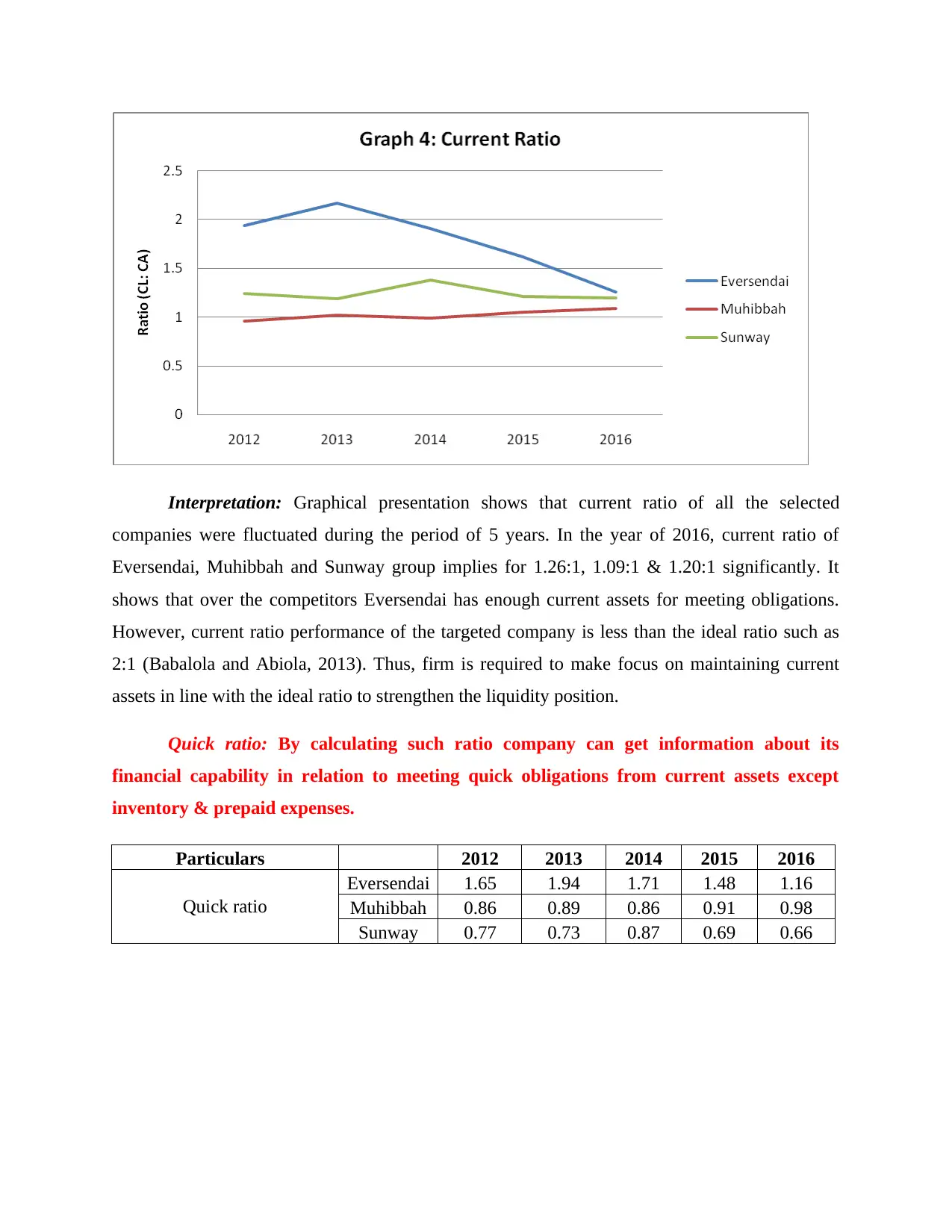
Interpretation: Graphical presentation shows that current ratio of all the selected
companies were fluctuated during the period of 5 years. In the year of 2016, current ratio of
Eversendai, Muhibbah and Sunway group implies for 1.26:1, 1.09:1 & 1.20:1 significantly. It
shows that over the competitors Eversendai has enough current assets for meeting obligations.
However, current ratio performance of the targeted company is less than the ideal ratio such as
2:1 (Babalola and Abiola, 2013). Thus, firm is required to make focus on maintaining current
assets in line with the ideal ratio to strengthen the liquidity position.
Quick ratio: By calculating such ratio company can get information about its
financial capability in relation to meeting quick obligations from current assets except
inventory & prepaid expenses.
Particulars 2012 2013 2014 2015 2016
Quick ratio
Eversendai 1.65 1.94 1.71 1.48 1.16
Muhibbah 0.86 0.89 0.86 0.91 0.98
Sunway 0.77 0.73 0.87 0.69 0.66
companies were fluctuated during the period of 5 years. In the year of 2016, current ratio of
Eversendai, Muhibbah and Sunway group implies for 1.26:1, 1.09:1 & 1.20:1 significantly. It
shows that over the competitors Eversendai has enough current assets for meeting obligations.
However, current ratio performance of the targeted company is less than the ideal ratio such as
2:1 (Babalola and Abiola, 2013). Thus, firm is required to make focus on maintaining current
assets in line with the ideal ratio to strengthen the liquidity position.
Quick ratio: By calculating such ratio company can get information about its
financial capability in relation to meeting quick obligations from current assets except
inventory & prepaid expenses.
Particulars 2012 2013 2014 2015 2016
Quick ratio
Eversendai 1.65 1.94 1.71 1.48 1.16
Muhibbah 0.86 0.89 0.86 0.91 0.98
Sunway 0.77 0.73 0.87 0.69 0.66
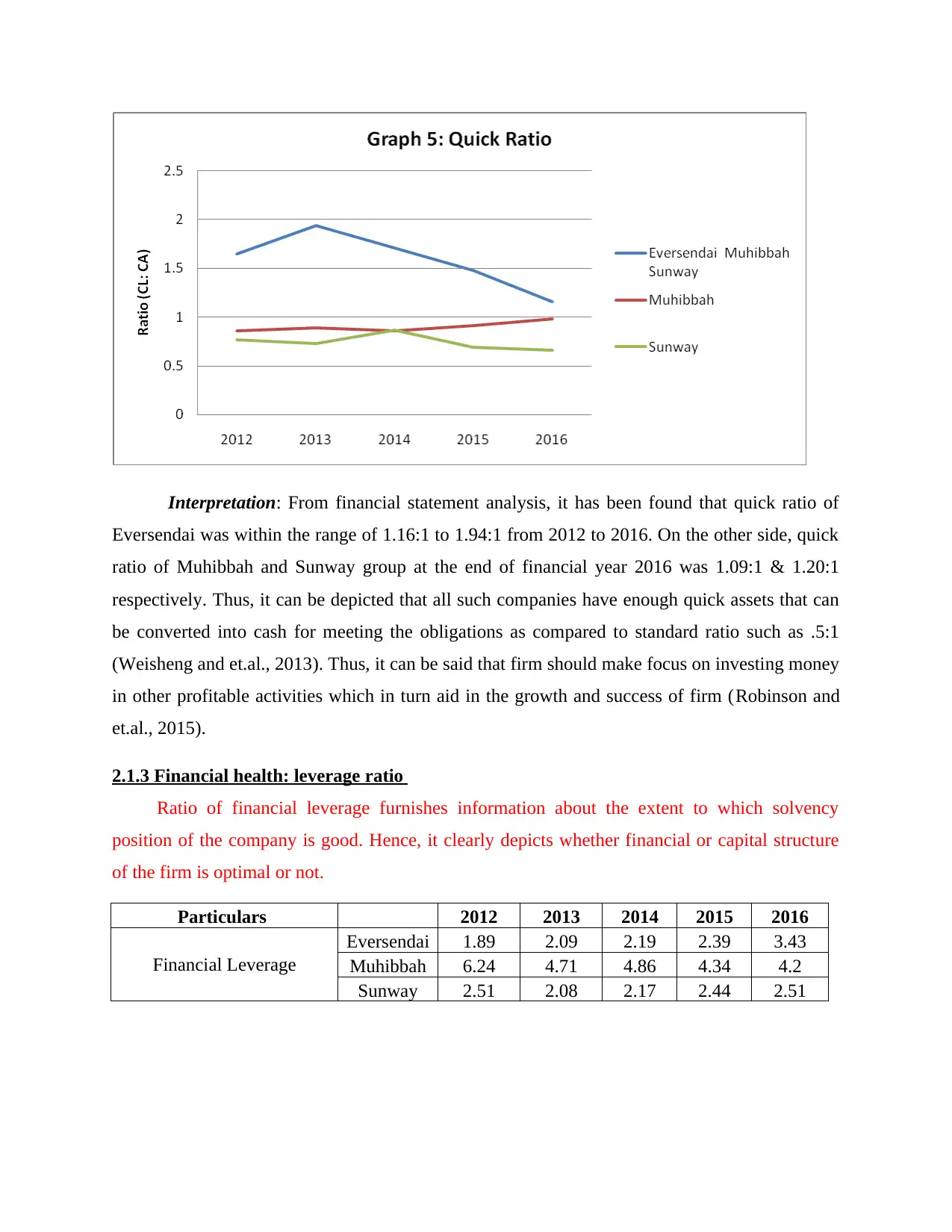
Interpretation: From financial statement analysis, it has been found that quick ratio of
Eversendai was within the range of 1.16:1 to 1.94:1 from 2012 to 2016. On the other side, quick
ratio of Muhibbah and Sunway group at the end of financial year 2016 was 1.09:1 & 1.20:1
respectively. Thus, it can be depicted that all such companies have enough quick assets that can
be converted into cash for meeting the obligations as compared to standard ratio such as .5:1
(Weisheng and et.al., 2013). Thus, it can be said that firm should make focus on investing money
in other profitable activities which in turn aid in the growth and success of firm (Robinson and
et.al., 2015).
2.1.3 Financial health: leverage ratio
Ratio of financial leverage furnishes information about the extent to which solvency
position of the company is good. Hence, it clearly depicts whether financial or capital structure
of the firm is optimal or not.
Particulars 2012 2013 2014 2015 2016
Financial Leverage
Eversendai 1.89 2.09 2.19 2.39 3.43
Muhibbah 6.24 4.71 4.86 4.34 4.2
Sunway 2.51 2.08 2.17 2.44 2.51
Eversendai was within the range of 1.16:1 to 1.94:1 from 2012 to 2016. On the other side, quick
ratio of Muhibbah and Sunway group at the end of financial year 2016 was 1.09:1 & 1.20:1
respectively. Thus, it can be depicted that all such companies have enough quick assets that can
be converted into cash for meeting the obligations as compared to standard ratio such as .5:1
(Weisheng and et.al., 2013). Thus, it can be said that firm should make focus on investing money
in other profitable activities which in turn aid in the growth and success of firm (Robinson and
et.al., 2015).
2.1.3 Financial health: leverage ratio
Ratio of financial leverage furnishes information about the extent to which solvency
position of the company is good. Hence, it clearly depicts whether financial or capital structure
of the firm is optimal or not.
Particulars 2012 2013 2014 2015 2016
Financial Leverage
Eversendai 1.89 2.09 2.19 2.39 3.43
Muhibbah 6.24 4.71 4.86 4.34 4.2
Sunway 2.51 2.08 2.17 2.44 2.51
Secure Best Marks with AI Grader
Need help grading? Try our AI Grader for instant feedback on your assignments.
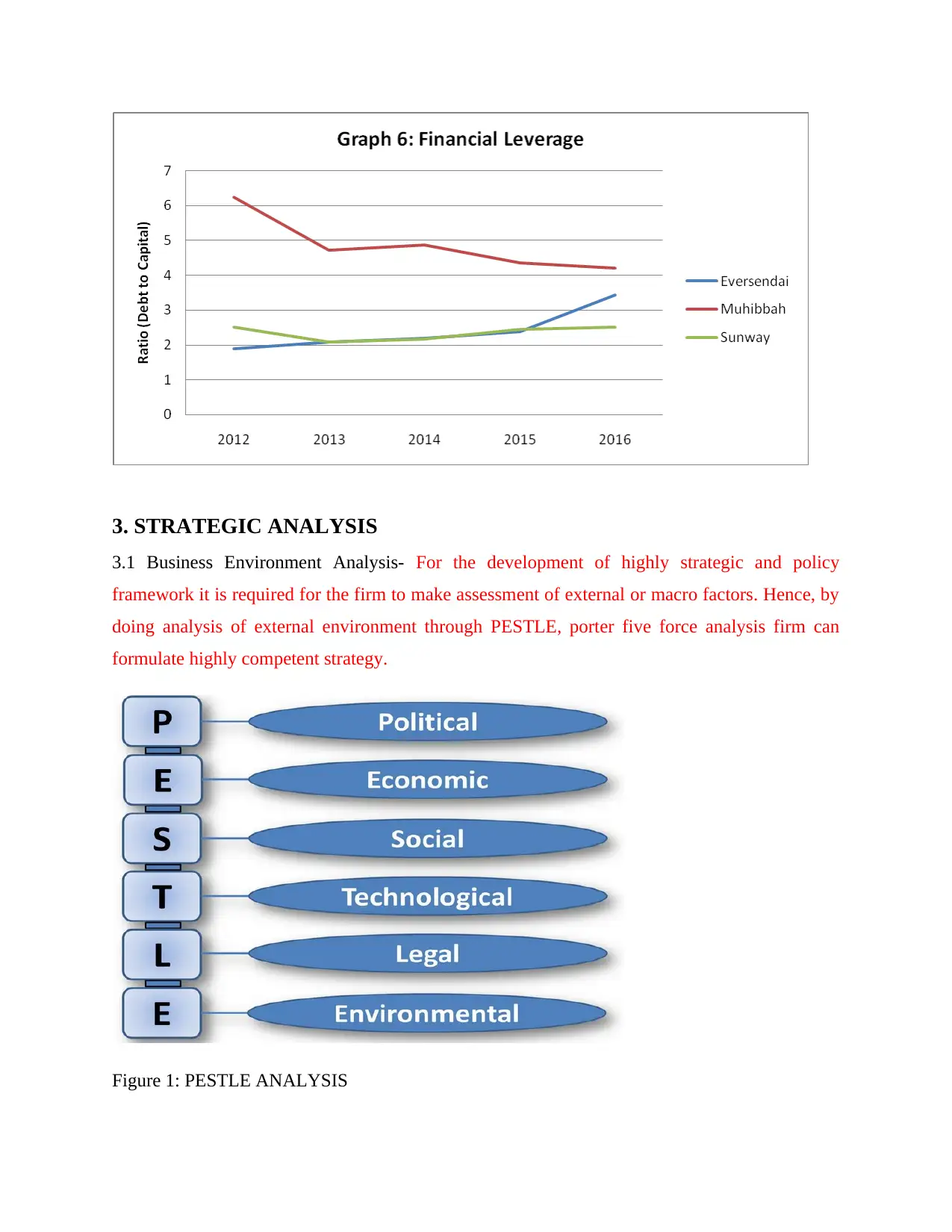
3. STRATEGIC ANALYSIS
3.1 Business Environment Analysis- For the development of highly strategic and policy
framework it is required for the firm to make assessment of external or macro factors. Hence, by
doing analysis of external environment through PESTLE, porter five force analysis firm can
formulate highly competent strategy.
Figure 1: PESTLE ANALYSIS
3.1 Business Environment Analysis- For the development of highly strategic and policy
framework it is required for the firm to make assessment of external or macro factors. Hence, by
doing analysis of external environment through PESTLE, porter five force analysis firm can
formulate highly competent strategy.
Figure 1: PESTLE ANALYSIS

(Source: Weisheng 2013 )
3.1.1 Political – Favourable
There is no political difficulty is deducted which can impact the cited organisation. The cost of
crude oil is expanded at the time when new goods and service tax is presented in Malaysia
(PESTLE analysis of Malaysia, 2017). Further in Malaysia's and Singapore the labour cost is the
lowest pay and it is permitted by Law control.
3.1.2 Economic– Unfavourable
There is some negative effect of economy on the firm. Singapore is stable monetarily and will
continue with the phenomenal monetary (McDonald and Wilson, 2016). Further the expansion of
business relied upon the hold that is 3%. On the other hand economies stay solid nevertheless
dropping and it is awaited that it will bounce back.
3.1.3 Social – Favourable
There are some social needs of country which is adjusted by the Eversendai, for instance it can
be stated that Malaysia's and Singapore who ties with business accomplice in Middle Eastern
nations which enable the firm to deal with different social difficulties (PESTLE analysis of
Malaysia, 2017).
3.1.4 Technological–Favourable
There is some capacity to adjust the vast majority of the innovation in their business. Further the
development in business is dynamic and specially in the oil and gas industry where the core
interest is in improvement (Chiang, Chen and Ho, 2016).
3.1.1 Political – Favourable
There is no political difficulty is deducted which can impact the cited organisation. The cost of
crude oil is expanded at the time when new goods and service tax is presented in Malaysia
(PESTLE analysis of Malaysia, 2017). Further in Malaysia's and Singapore the labour cost is the
lowest pay and it is permitted by Law control.
3.1.2 Economic– Unfavourable
There is some negative effect of economy on the firm. Singapore is stable monetarily and will
continue with the phenomenal monetary (McDonald and Wilson, 2016). Further the expansion of
business relied upon the hold that is 3%. On the other hand economies stay solid nevertheless
dropping and it is awaited that it will bounce back.
3.1.3 Social – Favourable
There are some social needs of country which is adjusted by the Eversendai, for instance it can
be stated that Malaysia's and Singapore who ties with business accomplice in Middle Eastern
nations which enable the firm to deal with different social difficulties (PESTLE analysis of
Malaysia, 2017).
3.1.4 Technological–Favourable
There is some capacity to adjust the vast majority of the innovation in their business. Further the
development in business is dynamic and specially in the oil and gas industry where the core
interest is in improvement (Chiang, Chen and Ho, 2016).
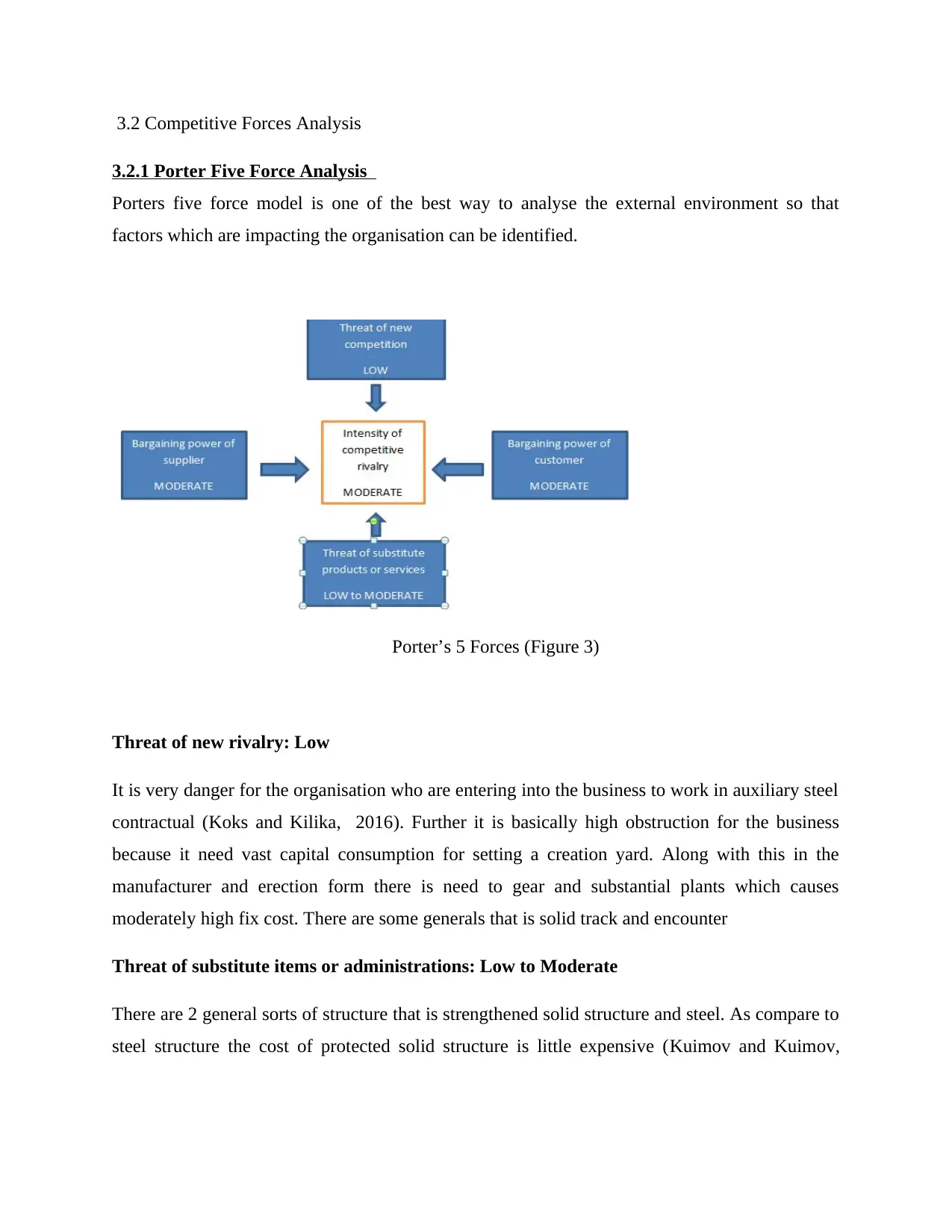
3.2 Competitive Forces Analysis
3.2.1 Porter Five Force Analysis
Porters five force model is one of the best way to analyse the external environment so that
factors which are impacting the organisation can be identified.
Porter’s 5 Forces (Figure 3)
Threat of new rivalry: Low
It is very danger for the organisation who are entering into the business to work in auxiliary steel
contractual (Koks and Kilika, 2016). Further it is basically high obstruction for the business
because it need vast capital consumption for setting a creation yard. Along with this in the
manufacturer and erection form there is need to gear and substantial plants which causes
moderately high fix cost. There are some generals that is solid track and encounter
Threat of substitute items or administrations: Low to Moderate
There are 2 general sorts of structure that is strengthened solid structure and steel. As compare to
steel structure the cost of protected solid structure is little expensive (Kuimov and Kuimov,
3.2.1 Porter Five Force Analysis
Porters five force model is one of the best way to analyse the external environment so that
factors which are impacting the organisation can be identified.
Porter’s 5 Forces (Figure 3)
Threat of new rivalry: Low
It is very danger for the organisation who are entering into the business to work in auxiliary steel
contractual (Koks and Kilika, 2016). Further it is basically high obstruction for the business
because it need vast capital consumption for setting a creation yard. Along with this in the
manufacturer and erection form there is need to gear and substantial plants which causes
moderately high fix cost. There are some generals that is solid track and encounter
Threat of substitute items or administrations: Low to Moderate
There are 2 general sorts of structure that is strengthened solid structure and steel. As compare to
steel structure the cost of protected solid structure is little expensive (Kuimov and Kuimov,
Paraphrase This Document
Need a fresh take? Get an instant paraphrase of this document with our AI Paraphraser
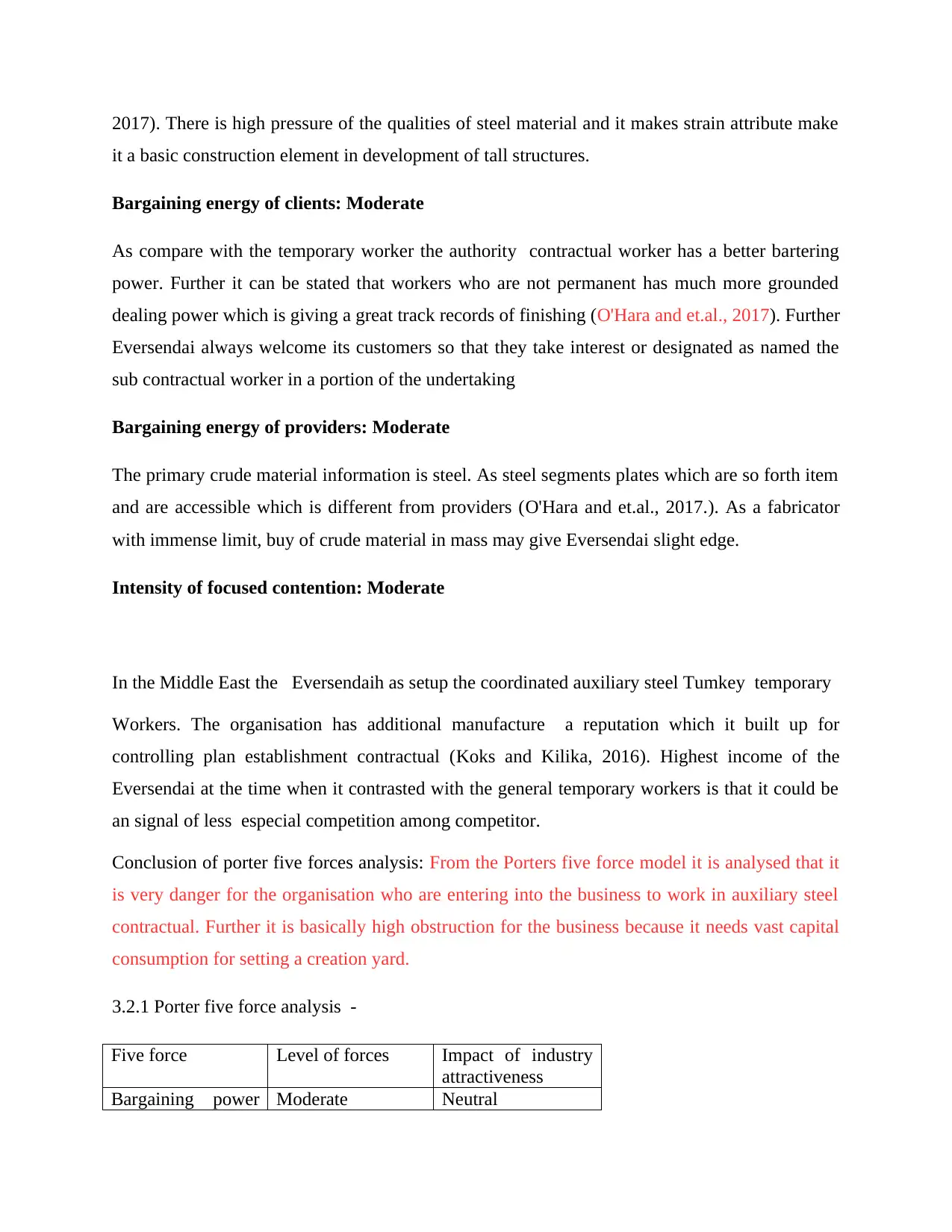
2017). There is high pressure of the qualities of steel material and it makes strain attribute make
it a basic construction element in development of tall structures.
Bargaining energy of clients: Moderate
As compare with the temporary worker the authority contractual worker has a better bartering
power. Further it can be stated that workers who are not permanent has much more grounded
dealing power which is giving a great track records of finishing (O'Hara and et.al., 2017). Further
Eversendai always welcome its customers so that they take interest or designated as named the
sub contractual worker in a portion of the undertaking
Bargaining energy of providers: Moderate
The primary crude material information is steel. As steel segments plates which are so forth item
and are accessible which is different from providers (O'Hara and et.al., 2017.). As a fabricator
with immense limit, buy of crude material in mass may give Eversendai slight edge.
Intensity of focused contention: Moderate
In the Middle East the Eversendaih as setup the coordinated auxiliary steel Tumkey temporary
Workers. The organisation has additional manufacture a reputation which it built up for
controlling plan establishment contractual (Koks and Kilika, 2016). Highest income of the
Eversendai at the time when it contrasted with the general temporary workers is that it could be
an signal of less especial competition among competitor.
Conclusion of porter five forces analysis: From the Porters five force model it is analysed that it
is very danger for the organisation who are entering into the business to work in auxiliary steel
contractual. Further it is basically high obstruction for the business because it needs vast capital
consumption for setting a creation yard.
3.2.1 Porter five force analysis -
Five force Level of forces Impact of industry
attractiveness
Bargaining power Moderate Neutral
it a basic construction element in development of tall structures.
Bargaining energy of clients: Moderate
As compare with the temporary worker the authority contractual worker has a better bartering
power. Further it can be stated that workers who are not permanent has much more grounded
dealing power which is giving a great track records of finishing (O'Hara and et.al., 2017). Further
Eversendai always welcome its customers so that they take interest or designated as named the
sub contractual worker in a portion of the undertaking
Bargaining energy of providers: Moderate
The primary crude material information is steel. As steel segments plates which are so forth item
and are accessible which is different from providers (O'Hara and et.al., 2017.). As a fabricator
with immense limit, buy of crude material in mass may give Eversendai slight edge.
Intensity of focused contention: Moderate
In the Middle East the Eversendaih as setup the coordinated auxiliary steel Tumkey temporary
Workers. The organisation has additional manufacture a reputation which it built up for
controlling plan establishment contractual (Koks and Kilika, 2016). Highest income of the
Eversendai at the time when it contrasted with the general temporary workers is that it could be
an signal of less especial competition among competitor.
Conclusion of porter five forces analysis: From the Porters five force model it is analysed that it
is very danger for the organisation who are entering into the business to work in auxiliary steel
contractual. Further it is basically high obstruction for the business because it needs vast capital
consumption for setting a creation yard.
3.2.1 Porter five force analysis -
Five force Level of forces Impact of industry
attractiveness
Bargaining power Moderate Neutral
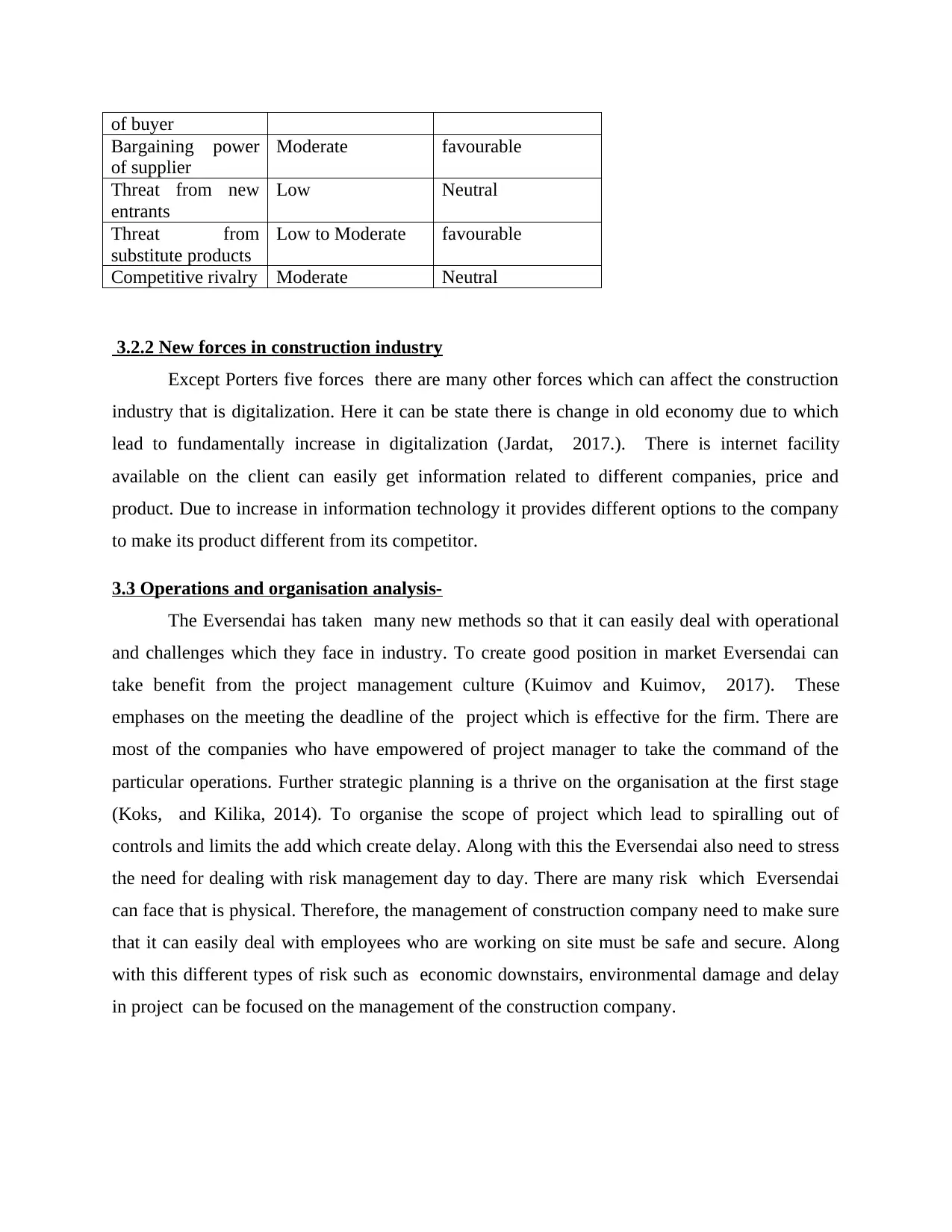
of buyer
Bargaining power
of supplier
Moderate favourable
Threat from new
entrants
Low Neutral
Threat from
substitute products
Low to Moderate favourable
Competitive rivalry Moderate Neutral
3.2.2 New forces in construction industry
Except Porters five forces there are many other forces which can affect the construction
industry that is digitalization. Here it can be state there is change in old economy due to which
lead to fundamentally increase in digitalization (Jardat, 2017.). There is internet facility
available on the client can easily get information related to different companies, price and
product. Due to increase in information technology it provides different options to the company
to make its product different from its competitor.
3.3 Operations and organisation analysis-
The Eversendai has taken many new methods so that it can easily deal with operational
and challenges which they face in industry. To create good position in market Eversendai can
take benefit from the project management culture (Kuimov and Kuimov, 2017). These
emphases on the meeting the deadline of the project which is effective for the firm. There are
most of the companies who have empowered of project manager to take the command of the
particular operations. Further strategic planning is a thrive on the organisation at the first stage
(Koks, and Kilika, 2014). To organise the scope of project which lead to spiralling out of
controls and limits the add which create delay. Along with this the Eversendai also need to stress
the need for dealing with risk management day to day. There are many risk which Eversendai
can face that is physical. Therefore, the management of construction company need to make sure
that it can easily deal with employees who are working on site must be safe and secure. Along
with this different types of risk such as economic downstairs, environmental damage and delay
in project can be focused on the management of the construction company.
Bargaining power
of supplier
Moderate favourable
Threat from new
entrants
Low Neutral
Threat from
substitute products
Low to Moderate favourable
Competitive rivalry Moderate Neutral
3.2.2 New forces in construction industry
Except Porters five forces there are many other forces which can affect the construction
industry that is digitalization. Here it can be state there is change in old economy due to which
lead to fundamentally increase in digitalization (Jardat, 2017.). There is internet facility
available on the client can easily get information related to different companies, price and
product. Due to increase in information technology it provides different options to the company
to make its product different from its competitor.
3.3 Operations and organisation analysis-
The Eversendai has taken many new methods so that it can easily deal with operational
and challenges which they face in industry. To create good position in market Eversendai can
take benefit from the project management culture (Kuimov and Kuimov, 2017). These
emphases on the meeting the deadline of the project which is effective for the firm. There are
most of the companies who have empowered of project manager to take the command of the
particular operations. Further strategic planning is a thrive on the organisation at the first stage
(Koks, and Kilika, 2014). To organise the scope of project which lead to spiralling out of
controls and limits the add which create delay. Along with this the Eversendai also need to stress
the need for dealing with risk management day to day. There are many risk which Eversendai
can face that is physical. Therefore, the management of construction company need to make sure
that it can easily deal with employees who are working on site must be safe and secure. Along
with this different types of risk such as economic downstairs, environmental damage and delay
in project can be focused on the management of the construction company.
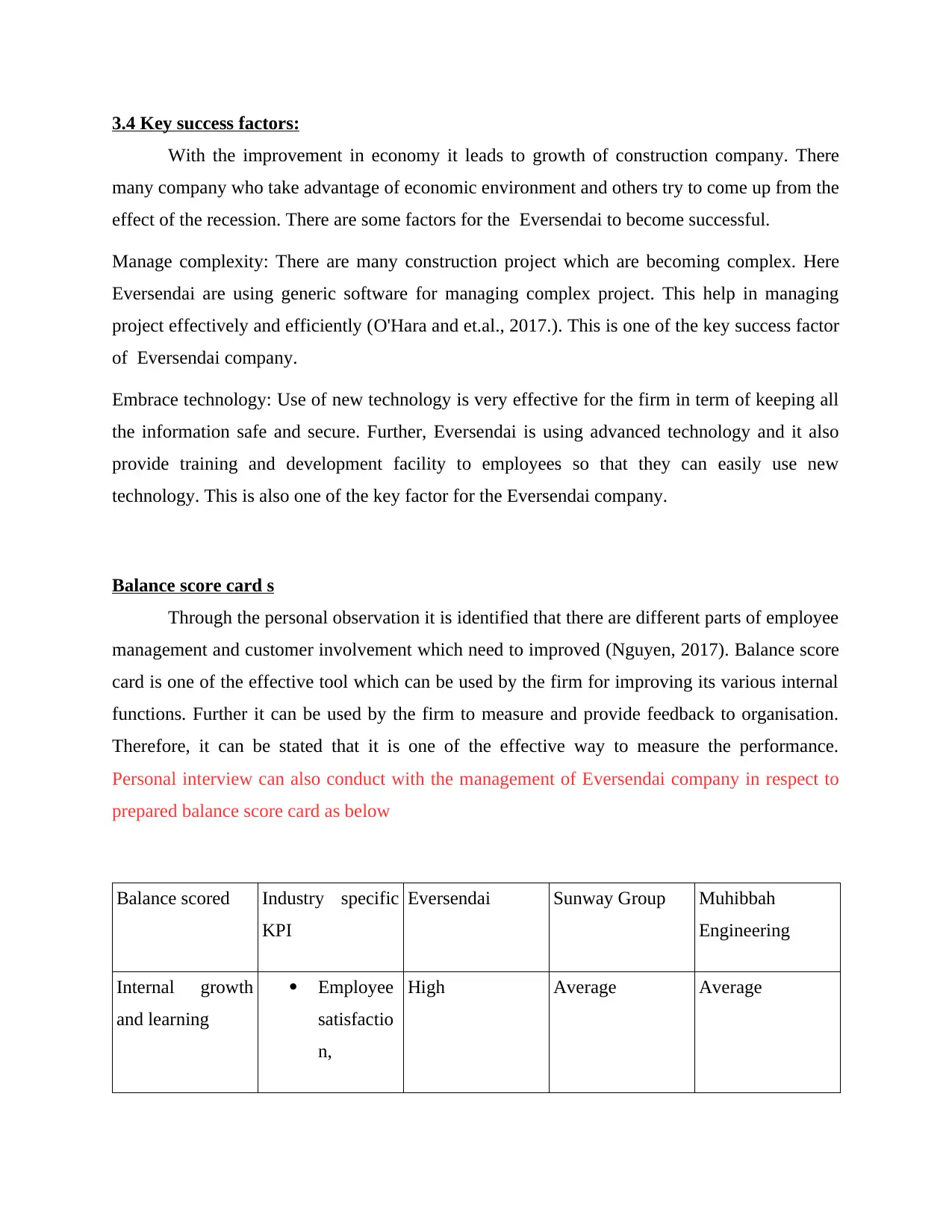
3.4 Key success factors:
With the improvement in economy it leads to growth of construction company. There
many company who take advantage of economic environment and others try to come up from the
effect of the recession. There are some factors for the Eversendai to become successful.
Manage complexity: There are many construction project which are becoming complex. Here
Eversendai are using generic software for managing complex project. This help in managing
project effectively and efficiently (O'Hara and et.al., 2017.). This is one of the key success factor
of Eversendai company.
Embrace technology: Use of new technology is very effective for the firm in term of keeping all
the information safe and secure. Further, Eversendai is using advanced technology and it also
provide training and development facility to employees so that they can easily use new
technology. This is also one of the key factor for the Eversendai company.
Balance score card s
Through the personal observation it is identified that there are different parts of employee
management and customer involvement which need to improved (Nguyen, 2017). Balance score
card is one of the effective tool which can be used by the firm for improving its various internal
functions. Further it can be used by the firm to measure and provide feedback to organisation.
Therefore, it can be stated that it is one of the effective way to measure the performance.
Personal interview can also conduct with the management of Eversendai company in respect to
prepared balance score card as below
Balance scored Industry specific
KPI
Eversendai Sunway Group Muhibbah
Engineering
Internal growth
and learning
Employee
satisfactio
n,
High Average Average
With the improvement in economy it leads to growth of construction company. There
many company who take advantage of economic environment and others try to come up from the
effect of the recession. There are some factors for the Eversendai to become successful.
Manage complexity: There are many construction project which are becoming complex. Here
Eversendai are using generic software for managing complex project. This help in managing
project effectively and efficiently (O'Hara and et.al., 2017.). This is one of the key success factor
of Eversendai company.
Embrace technology: Use of new technology is very effective for the firm in term of keeping all
the information safe and secure. Further, Eversendai is using advanced technology and it also
provide training and development facility to employees so that they can easily use new
technology. This is also one of the key factor for the Eversendai company.
Balance score card s
Through the personal observation it is identified that there are different parts of employee
management and customer involvement which need to improved (Nguyen, 2017). Balance score
card is one of the effective tool which can be used by the firm for improving its various internal
functions. Further it can be used by the firm to measure and provide feedback to organisation.
Therefore, it can be stated that it is one of the effective way to measure the performance.
Personal interview can also conduct with the management of Eversendai company in respect to
prepared balance score card as below
Balance scored Industry specific
KPI
Eversendai Sunway Group Muhibbah
Engineering
Internal growth
and learning
Employee
satisfactio
n,
High Average Average
Secure Best Marks with AI Grader
Need help grading? Try our AI Grader for instant feedback on your assignments.
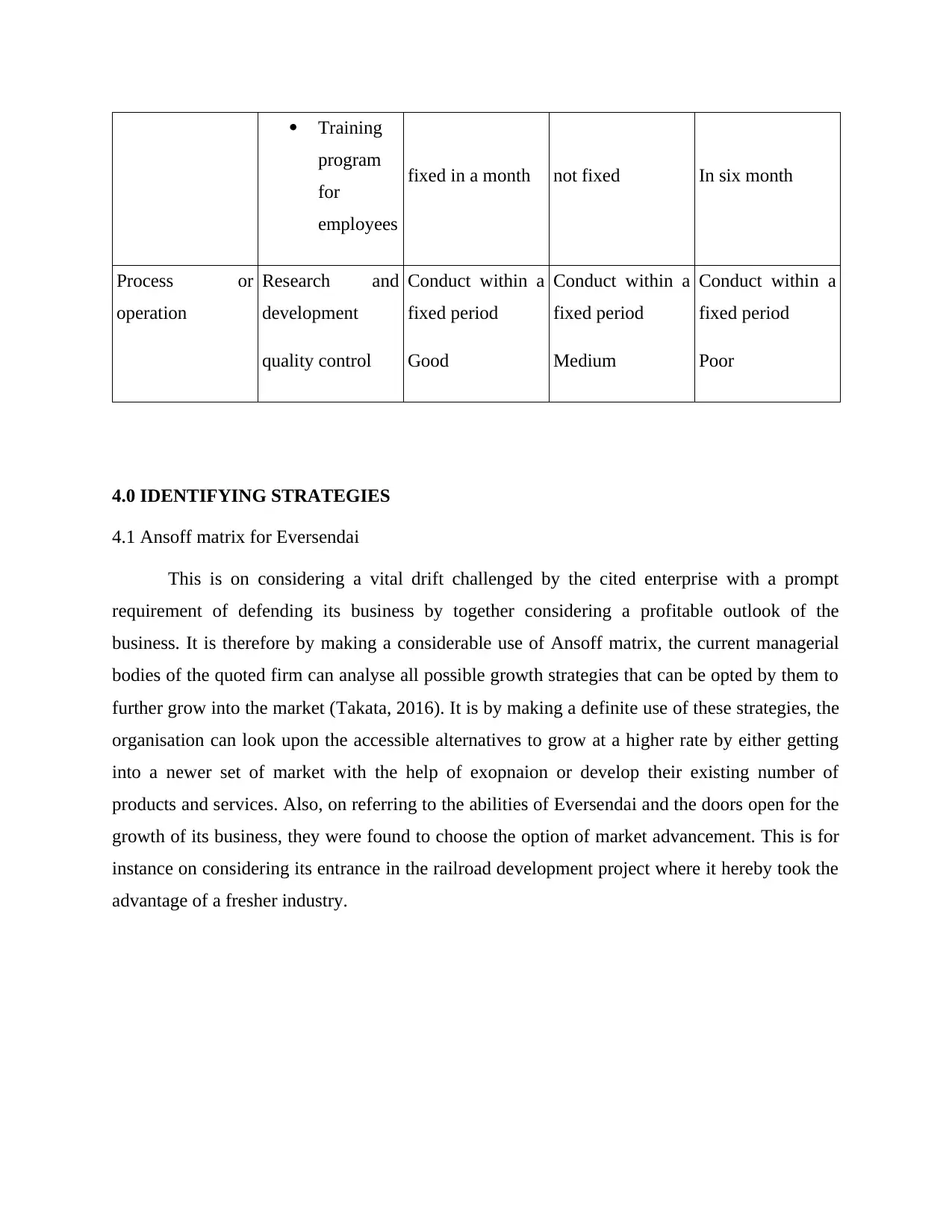
Training
program
for
employees
fixed in a month not fixed In six month
Process or
operation
Research and
development
quality control
Conduct within a
fixed period
Good
Conduct within a
fixed period
Medium
Conduct within a
fixed period
Poor
4.0 IDENTIFYING STRATEGIES
4.1 Ansoff matrix for Eversendai
This is on considering a vital drift challenged by the cited enterprise with a prompt
requirement of defending its business by together considering a profitable outlook of the
business. It is therefore by making a considerable use of Ansoff matrix, the current managerial
bodies of the quoted firm can analyse all possible growth strategies that can be opted by them to
further grow into the market (Takata, 2016). It is by making a definite use of these strategies, the
organisation can look upon the accessible alternatives to grow at a higher rate by either getting
into a newer set of market with the help of exopnaion or develop their existing number of
products and services. Also, on referring to the abilities of Eversendai and the doors open for the
growth of its business, they were found to choose the option of market advancement. This is for
instance on considering its entrance in the railroad development project where it hereby took the
advantage of a fresher industry.
program
for
employees
fixed in a month not fixed In six month
Process or
operation
Research and
development
quality control
Conduct within a
fixed period
Good
Conduct within a
fixed period
Medium
Conduct within a
fixed period
Poor
4.0 IDENTIFYING STRATEGIES
4.1 Ansoff matrix for Eversendai
This is on considering a vital drift challenged by the cited enterprise with a prompt
requirement of defending its business by together considering a profitable outlook of the
business. It is therefore by making a considerable use of Ansoff matrix, the current managerial
bodies of the quoted firm can analyse all possible growth strategies that can be opted by them to
further grow into the market (Takata, 2016). It is by making a definite use of these strategies, the
organisation can look upon the accessible alternatives to grow at a higher rate by either getting
into a newer set of market with the help of exopnaion or develop their existing number of
products and services. Also, on referring to the abilities of Eversendai and the doors open for the
growth of its business, they were found to choose the option of market advancement. This is for
instance on considering its entrance in the railroad development project where it hereby took the
advantage of a fresher industry.
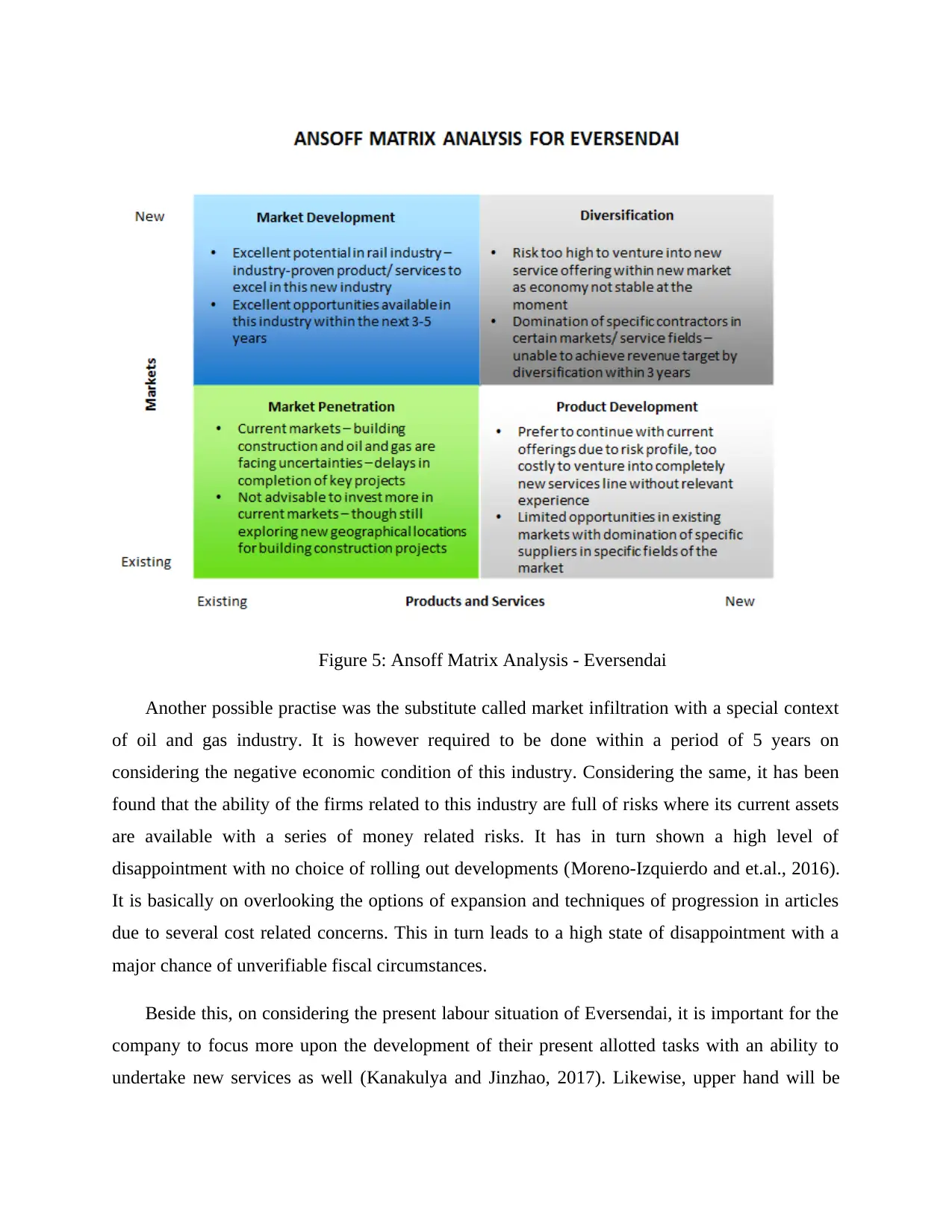
Figure 5: Ansoff Matrix Analysis - Eversendai
Another possible practise was the substitute called market infiltration with a special context
of oil and gas industry. It is however required to be done within a period of 5 years on
considering the negative economic condition of this industry. Considering the same, it has been
found that the ability of the firms related to this industry are full of risks where its current assets
are available with a series of money related risks. It has in turn shown a high level of
disappointment with no choice of rolling out developments (Moreno-Izquierdo and et.al., 2016).
It is basically on overlooking the options of expansion and techniques of progression in articles
due to several cost related concerns. This in turn leads to a high state of disappointment with a
major chance of unverifiable fiscal circumstances.
Beside this, on considering the present labour situation of Eversendai, it is important for the
company to focus more upon the development of their present allotted tasks with an ability to
undertake new services as well (Kanakulya and Jinzhao, 2017). Likewise, upper hand will be
Another possible practise was the substitute called market infiltration with a special context
of oil and gas industry. It is however required to be done within a period of 5 years on
considering the negative economic condition of this industry. Considering the same, it has been
found that the ability of the firms related to this industry are full of risks where its current assets
are available with a series of money related risks. It has in turn shown a high level of
disappointment with no choice of rolling out developments (Moreno-Izquierdo and et.al., 2016).
It is basically on overlooking the options of expansion and techniques of progression in articles
due to several cost related concerns. This in turn leads to a high state of disappointment with a
major chance of unverifiable fiscal circumstances.
Beside this, on considering the present labour situation of Eversendai, it is important for the
company to focus more upon the development of their present allotted tasks with an ability to
undertake new services as well (Kanakulya and Jinzhao, 2017). Likewise, upper hand will be
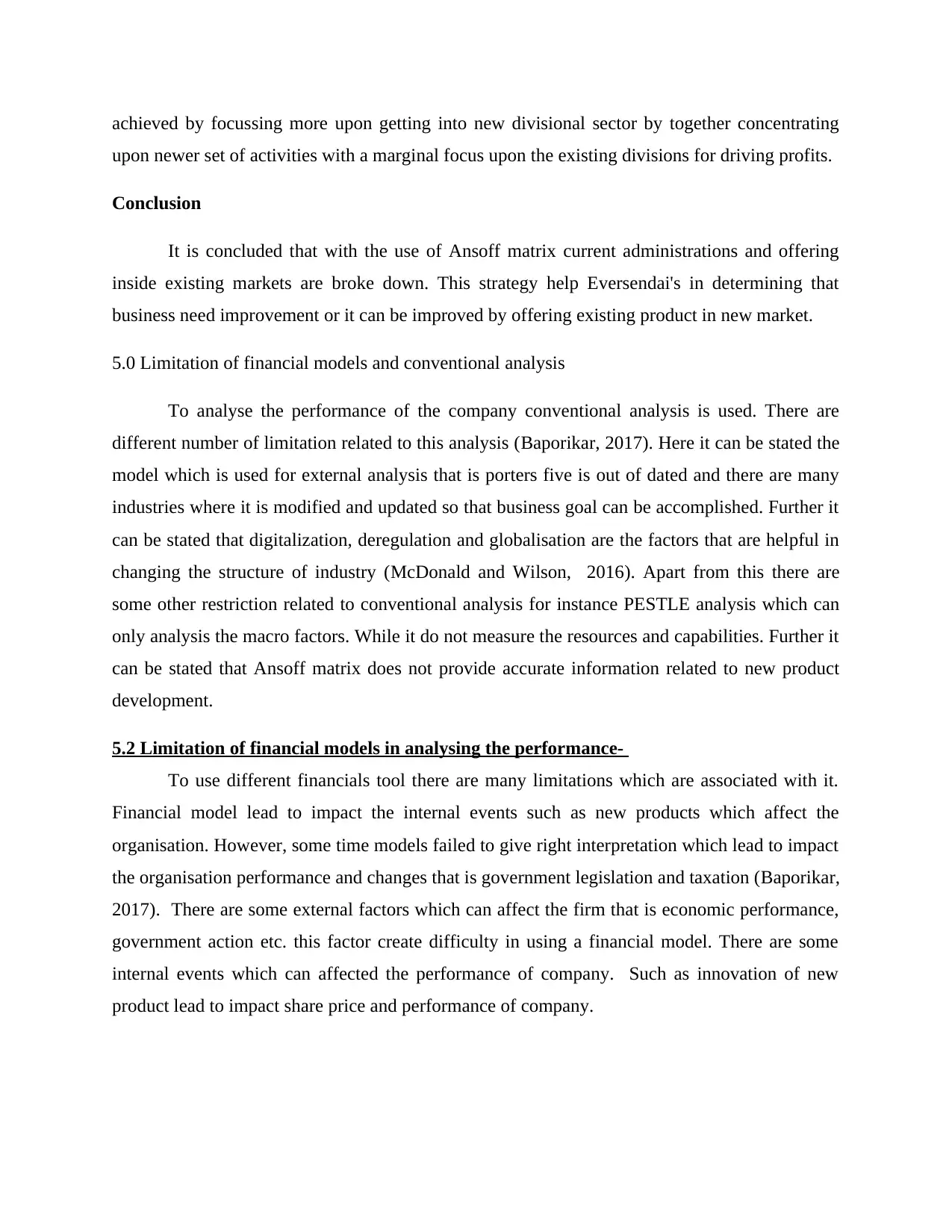
achieved by focussing more upon getting into new divisional sector by together concentrating
upon newer set of activities with a marginal focus upon the existing divisions for driving profits.
Conclusion
It is concluded that with the use of Ansoff matrix current administrations and offering
inside existing markets are broke down. This strategy help Eversendai's in determining that
business need improvement or it can be improved by offering existing product in new market.
5.0 Limitation of financial models and conventional analysis
To analyse the performance of the company conventional analysis is used. There are
different number of limitation related to this analysis (Baporikar, 2017). Here it can be stated the
model which is used for external analysis that is porters five is out of dated and there are many
industries where it is modified and updated so that business goal can be accomplished. Further it
can be stated that digitalization, deregulation and globalisation are the factors that are helpful in
changing the structure of industry (McDonald and Wilson, 2016). Apart from this there are
some other restriction related to conventional analysis for instance PESTLE analysis which can
only analysis the macro factors. While it do not measure the resources and capabilities. Further it
can be stated that Ansoff matrix does not provide accurate information related to new product
development.
5.2 Limitation of financial models in analysing the performance-
To use different financials tool there are many limitations which are associated with it.
Financial model lead to impact the internal events such as new products which affect the
organisation. However, some time models failed to give right interpretation which lead to impact
the organisation performance and changes that is government legislation and taxation (Baporikar,
2017). There are some external factors which can affect the firm that is economic performance,
government action etc. this factor create difficulty in using a financial model. There are some
internal events which can affected the performance of company. Such as innovation of new
product lead to impact share price and performance of company.
upon newer set of activities with a marginal focus upon the existing divisions for driving profits.
Conclusion
It is concluded that with the use of Ansoff matrix current administrations and offering
inside existing markets are broke down. This strategy help Eversendai's in determining that
business need improvement or it can be improved by offering existing product in new market.
5.0 Limitation of financial models and conventional analysis
To analyse the performance of the company conventional analysis is used. There are
different number of limitation related to this analysis (Baporikar, 2017). Here it can be stated the
model which is used for external analysis that is porters five is out of dated and there are many
industries where it is modified and updated so that business goal can be accomplished. Further it
can be stated that digitalization, deregulation and globalisation are the factors that are helpful in
changing the structure of industry (McDonald and Wilson, 2016). Apart from this there are
some other restriction related to conventional analysis for instance PESTLE analysis which can
only analysis the macro factors. While it do not measure the resources and capabilities. Further it
can be stated that Ansoff matrix does not provide accurate information related to new product
development.
5.2 Limitation of financial models in analysing the performance-
To use different financials tool there are many limitations which are associated with it.
Financial model lead to impact the internal events such as new products which affect the
organisation. However, some time models failed to give right interpretation which lead to impact
the organisation performance and changes that is government legislation and taxation (Baporikar,
2017). There are some external factors which can affect the firm that is economic performance,
government action etc. this factor create difficulty in using a financial model. There are some
internal events which can affected the performance of company. Such as innovation of new
product lead to impact share price and performance of company.
Paraphrase This Document
Need a fresh take? Get an instant paraphrase of this document with our AI Paraphraser
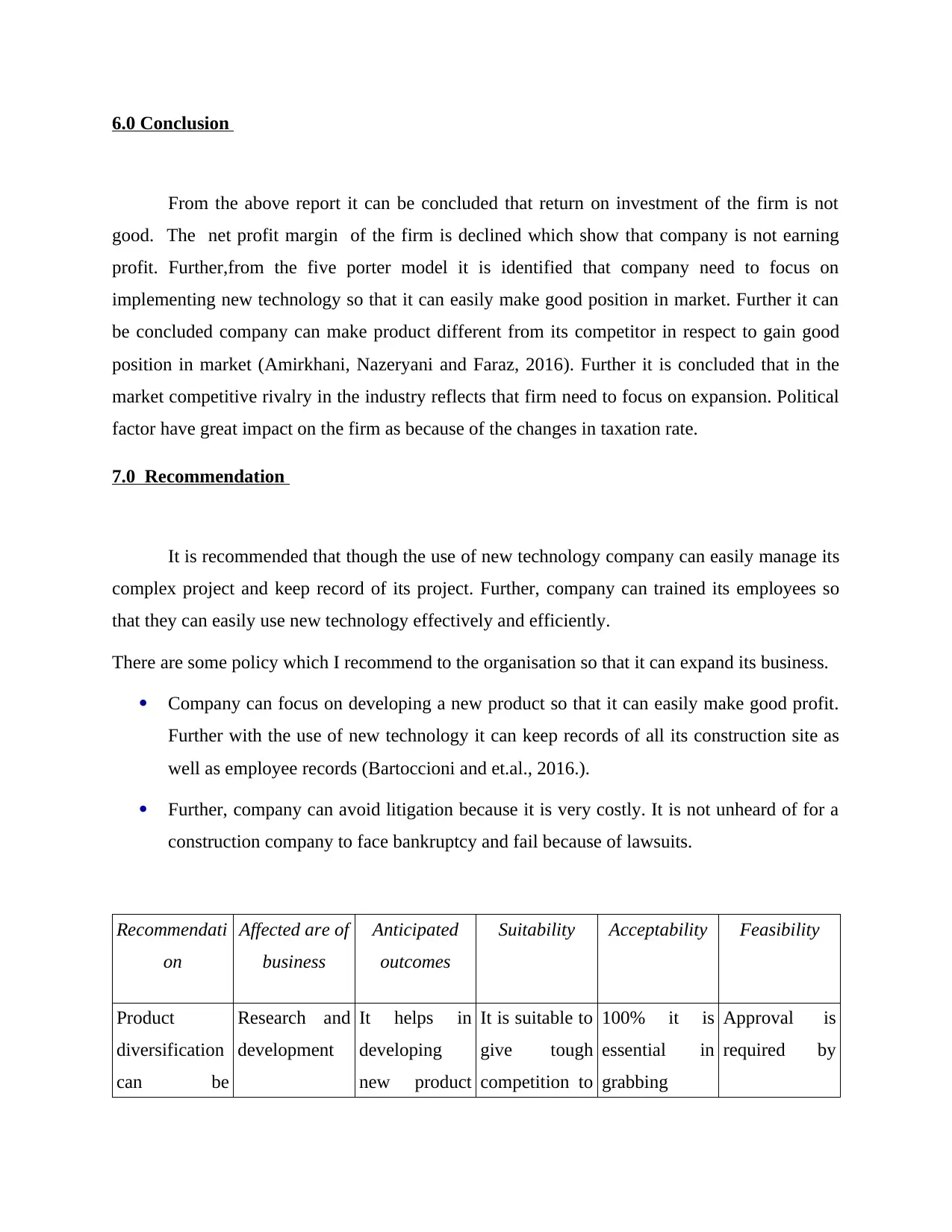
6.0 Conclusion
From the above report it can be concluded that return on investment of the firm is not
good. The net profit margin of the firm is declined which show that company is not earning
profit. Further,from the five porter model it is identified that company need to focus on
implementing new technology so that it can easily make good position in market. Further it can
be concluded company can make product different from its competitor in respect to gain good
position in market (Amirkhani, Nazeryani and Faraz, 2016). Further it is concluded that in the
market competitive rivalry in the industry reflects that firm need to focus on expansion. Political
factor have great impact on the firm as because of the changes in taxation rate.
7.0 Recommendation
It is recommended that though the use of new technology company can easily manage its
complex project and keep record of its project. Further, company can trained its employees so
that they can easily use new technology effectively and efficiently.
There are some policy which I recommend to the organisation so that it can expand its business.
Company can focus on developing a new product so that it can easily make good profit.
Further with the use of new technology it can keep records of all its construction site as
well as employee records (Bartoccioni and et.al., 2016.).
Further, company can avoid litigation because it is very costly. It is not unheard of for a
construction company to face bankruptcy and fail because of lawsuits.
Recommendati
on
Affected are of
business
Anticipated
outcomes
Suitability Acceptability Feasibility
Product
diversification
can be
Research and
development
It helps in
developing
new product
It is suitable to
give tough
competition to
100% it is
essential in
grabbing
Approval is
required by
From the above report it can be concluded that return on investment of the firm is not
good. The net profit margin of the firm is declined which show that company is not earning
profit. Further,from the five porter model it is identified that company need to focus on
implementing new technology so that it can easily make good position in market. Further it can
be concluded company can make product different from its competitor in respect to gain good
position in market (Amirkhani, Nazeryani and Faraz, 2016). Further it is concluded that in the
market competitive rivalry in the industry reflects that firm need to focus on expansion. Political
factor have great impact on the firm as because of the changes in taxation rate.
7.0 Recommendation
It is recommended that though the use of new technology company can easily manage its
complex project and keep record of its project. Further, company can trained its employees so
that they can easily use new technology effectively and efficiently.
There are some policy which I recommend to the organisation so that it can expand its business.
Company can focus on developing a new product so that it can easily make good profit.
Further with the use of new technology it can keep records of all its construction site as
well as employee records (Bartoccioni and et.al., 2016.).
Further, company can avoid litigation because it is very costly. It is not unheard of for a
construction company to face bankruptcy and fail because of lawsuits.
Recommendati
on
Affected are of
business
Anticipated
outcomes
Suitability Acceptability Feasibility
Product
diversification
can be
Research and
development
It helps in
developing
new product
It is suitable to
give tough
competition to
100% it is
essential in
grabbing
Approval is
required by

accomplish
through
entering into a
new market or
by pricing
strategies.
for customers other
competitor
attention of
customers
management.
through
entering into a
new market or
by pricing
strategies.
for customers other
competitor
attention of
customers
management.
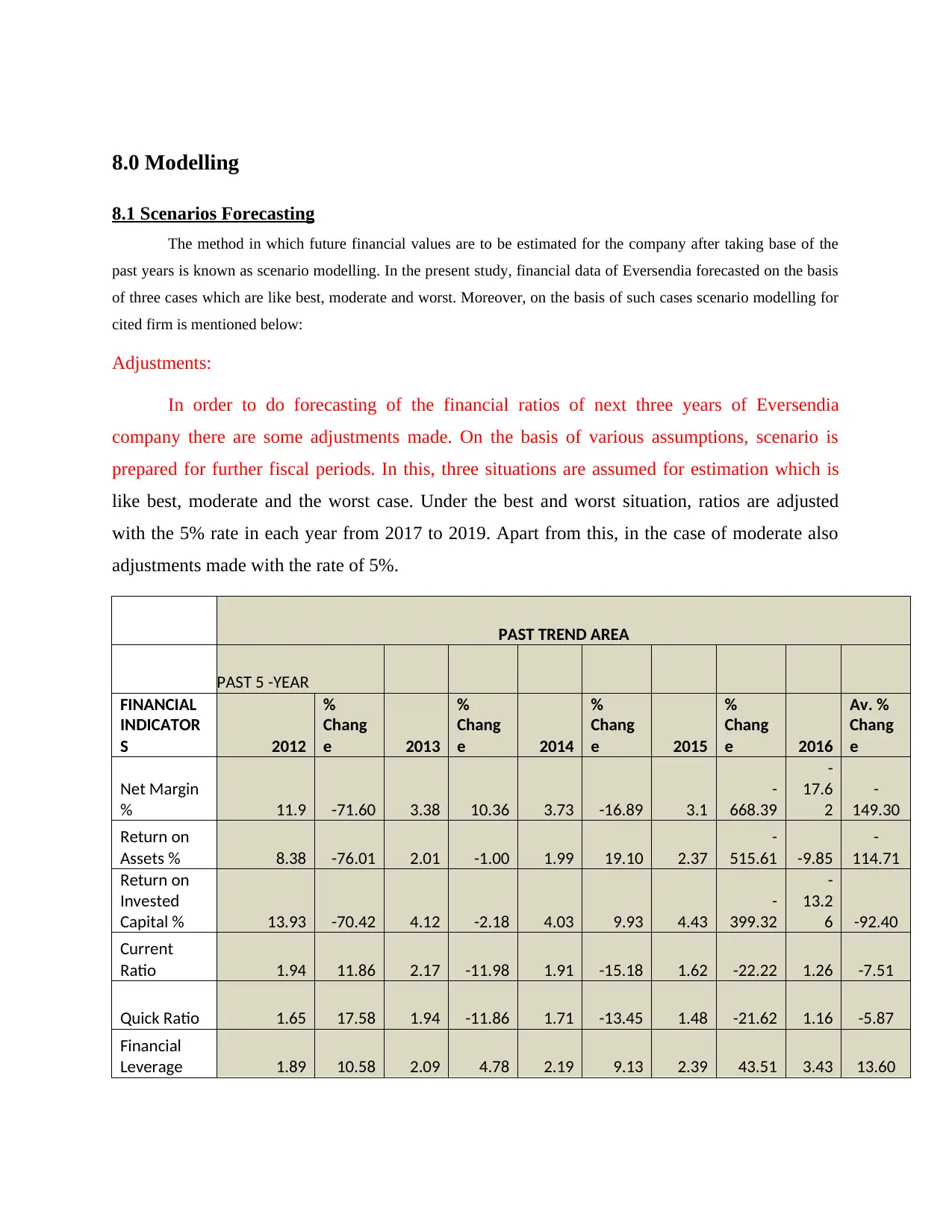
8.0 Modelling
8.1 Scenarios Forecasting
The method in which future financial values are to be estimated for the company after taking base of the
past years is known as scenario modelling. In the present study, financial data of Eversendia forecasted on the basis
of three cases which are like best, moderate and worst. Moreover, on the basis of such cases scenario modelling for
cited firm is mentioned below:
Adjustments:
In order to do forecasting of the financial ratios of next three years of Eversendia
company there are some adjustments made. On the basis of various assumptions, scenario is
prepared for further fiscal periods. In this, three situations are assumed for estimation which is
like best, moderate and the worst case. Under the best and worst situation, ratios are adjusted
with the 5% rate in each year from 2017 to 2019. Apart from this, in the case of moderate also
adjustments made with the rate of 5%.
PAST TREND AREA
PAST 5 -YEAR
FINANCIAL
INDICATOR
S 2012
%
Chang
e 2013
%
Chang
e 2014
%
Chang
e 2015
%
Chang
e 2016
Av. %
Chang
e
Net Margin
% 11.9 -71.60 3.38 10.36 3.73 -16.89 3.1
-
668.39
-
17.6
2
-
149.30
Return on
Assets % 8.38 -76.01 2.01 -1.00 1.99 19.10 2.37
-
515.61 -9.85
-
114.71
Return on
Invested
Capital % 13.93 -70.42 4.12 -2.18 4.03 9.93 4.43
-
399.32
-
13.2
6 -92.40
Current
Ratio 1.94 11.86 2.17 -11.98 1.91 -15.18 1.62 -22.22 1.26 -7.51
Quick Ratio 1.65 17.58 1.94 -11.86 1.71 -13.45 1.48 -21.62 1.16 -5.87
Financial
Leverage 1.89 10.58 2.09 4.78 2.19 9.13 2.39 43.51 3.43 13.60
8.1 Scenarios Forecasting
The method in which future financial values are to be estimated for the company after taking base of the
past years is known as scenario modelling. In the present study, financial data of Eversendia forecasted on the basis
of three cases which are like best, moderate and worst. Moreover, on the basis of such cases scenario modelling for
cited firm is mentioned below:
Adjustments:
In order to do forecasting of the financial ratios of next three years of Eversendia
company there are some adjustments made. On the basis of various assumptions, scenario is
prepared for further fiscal periods. In this, three situations are assumed for estimation which is
like best, moderate and the worst case. Under the best and worst situation, ratios are adjusted
with the 5% rate in each year from 2017 to 2019. Apart from this, in the case of moderate also
adjustments made with the rate of 5%.
PAST TREND AREA
PAST 5 -YEAR
FINANCIAL
INDICATOR
S 2012
%
Chang
e 2013
%
Chang
e 2014
%
Chang
e 2015
%
Chang
e 2016
Av. %
Chang
e
Net Margin
% 11.9 -71.60 3.38 10.36 3.73 -16.89 3.1
-
668.39
-
17.6
2
-
149.30
Return on
Assets % 8.38 -76.01 2.01 -1.00 1.99 19.10 2.37
-
515.61 -9.85
-
114.71
Return on
Invested
Capital % 13.93 -70.42 4.12 -2.18 4.03 9.93 4.43
-
399.32
-
13.2
6 -92.40
Current
Ratio 1.94 11.86 2.17 -11.98 1.91 -15.18 1.62 -22.22 1.26 -7.51
Quick Ratio 1.65 17.58 1.94 -11.86 1.71 -13.45 1.48 -21.62 1.16 -5.87
Financial
Leverage 1.89 10.58 2.09 4.78 2.19 9.13 2.39 43.51 3.43 13.60
Secure Best Marks with AI Grader
Need help grading? Try our AI Grader for instant feedback on your assignments.
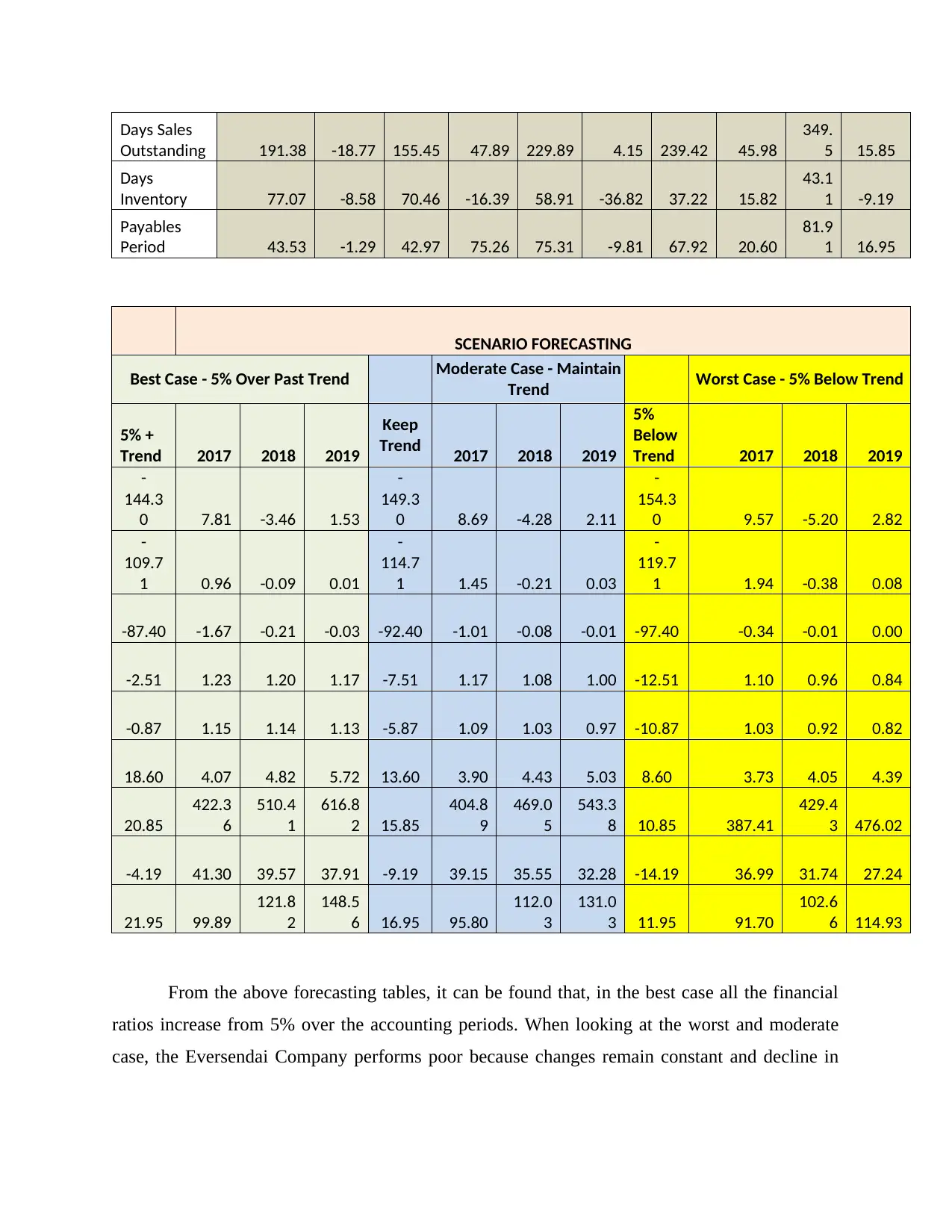
Days Sales
Outstanding 191.38 -18.77 155.45 47.89 229.89 4.15 239.42 45.98
349.
5 15.85
Days
Inventory 77.07 -8.58 70.46 -16.39 58.91 -36.82 37.22 15.82
43.1
1 -9.19
Payables
Period 43.53 -1.29 42.97 75.26 75.31 -9.81 67.92 20.60
81.9
1 16.95
SCENARIO FORECASTING
Best Case - 5% Over Past Trend Moderate Case - Maintain
Trend Worst Case - 5% Below Trend
5% +
Trend 2017 2018 2019
Keep
Trend 2017 2018 2019
5%
Below
Trend 2017 2018 2019
-
144.3
0 7.81 -3.46 1.53
-
149.3
0 8.69 -4.28 2.11
-
154.3
0 9.57 -5.20 2.82
-
109.7
1 0.96 -0.09 0.01
-
114.7
1 1.45 -0.21 0.03
-
119.7
1 1.94 -0.38 0.08
-87.40 -1.67 -0.21 -0.03 -92.40 -1.01 -0.08 -0.01 -97.40 -0.34 -0.01 0.00
-2.51 1.23 1.20 1.17 -7.51 1.17 1.08 1.00 -12.51 1.10 0.96 0.84
-0.87 1.15 1.14 1.13 -5.87 1.09 1.03 0.97 -10.87 1.03 0.92 0.82
18.60 4.07 4.82 5.72 13.60 3.90 4.43 5.03 8.60 3.73 4.05 4.39
20.85
422.3
6
510.4
1
616.8
2 15.85
404.8
9
469.0
5
543.3
8 10.85 387.41
429.4
3 476.02
-4.19 41.30 39.57 37.91 -9.19 39.15 35.55 32.28 -14.19 36.99 31.74 27.24
21.95 99.89
121.8
2
148.5
6 16.95 95.80
112.0
3
131.0
3 11.95 91.70
102.6
6 114.93
From the above forecasting tables, it can be found that, in the best case all the financial
ratios increase from 5% over the accounting periods. When looking at the worst and moderate
case, the Eversendai Company performs poor because changes remain constant and decline in
Outstanding 191.38 -18.77 155.45 47.89 229.89 4.15 239.42 45.98
349.
5 15.85
Days
Inventory 77.07 -8.58 70.46 -16.39 58.91 -36.82 37.22 15.82
43.1
1 -9.19
Payables
Period 43.53 -1.29 42.97 75.26 75.31 -9.81 67.92 20.60
81.9
1 16.95
SCENARIO FORECASTING
Best Case - 5% Over Past Trend Moderate Case - Maintain
Trend Worst Case - 5% Below Trend
5% +
Trend 2017 2018 2019
Keep
Trend 2017 2018 2019
5%
Below
Trend 2017 2018 2019
-
144.3
0 7.81 -3.46 1.53
-
149.3
0 8.69 -4.28 2.11
-
154.3
0 9.57 -5.20 2.82
-
109.7
1 0.96 -0.09 0.01
-
114.7
1 1.45 -0.21 0.03
-
119.7
1 1.94 -0.38 0.08
-87.40 -1.67 -0.21 -0.03 -92.40 -1.01 -0.08 -0.01 -97.40 -0.34 -0.01 0.00
-2.51 1.23 1.20 1.17 -7.51 1.17 1.08 1.00 -12.51 1.10 0.96 0.84
-0.87 1.15 1.14 1.13 -5.87 1.09 1.03 0.97 -10.87 1.03 0.92 0.82
18.60 4.07 4.82 5.72 13.60 3.90 4.43 5.03 8.60 3.73 4.05 4.39
20.85
422.3
6
510.4
1
616.8
2 15.85
404.8
9
469.0
5
543.3
8 10.85 387.41
429.4
3 476.02
-4.19 41.30 39.57 37.91 -9.19 39.15 35.55 32.28 -14.19 36.99 31.74 27.24
21.95 99.89
121.8
2
148.5
6 16.95 95.80
112.0
3
131.0
3 11.95 91.70
102.6
6 114.93
From the above forecasting tables, it can be found that, in the best case all the financial
ratios increase from 5% over the accounting periods. When looking at the worst and moderate
case, the Eversendai Company performs poor because changes remain constant and decline in
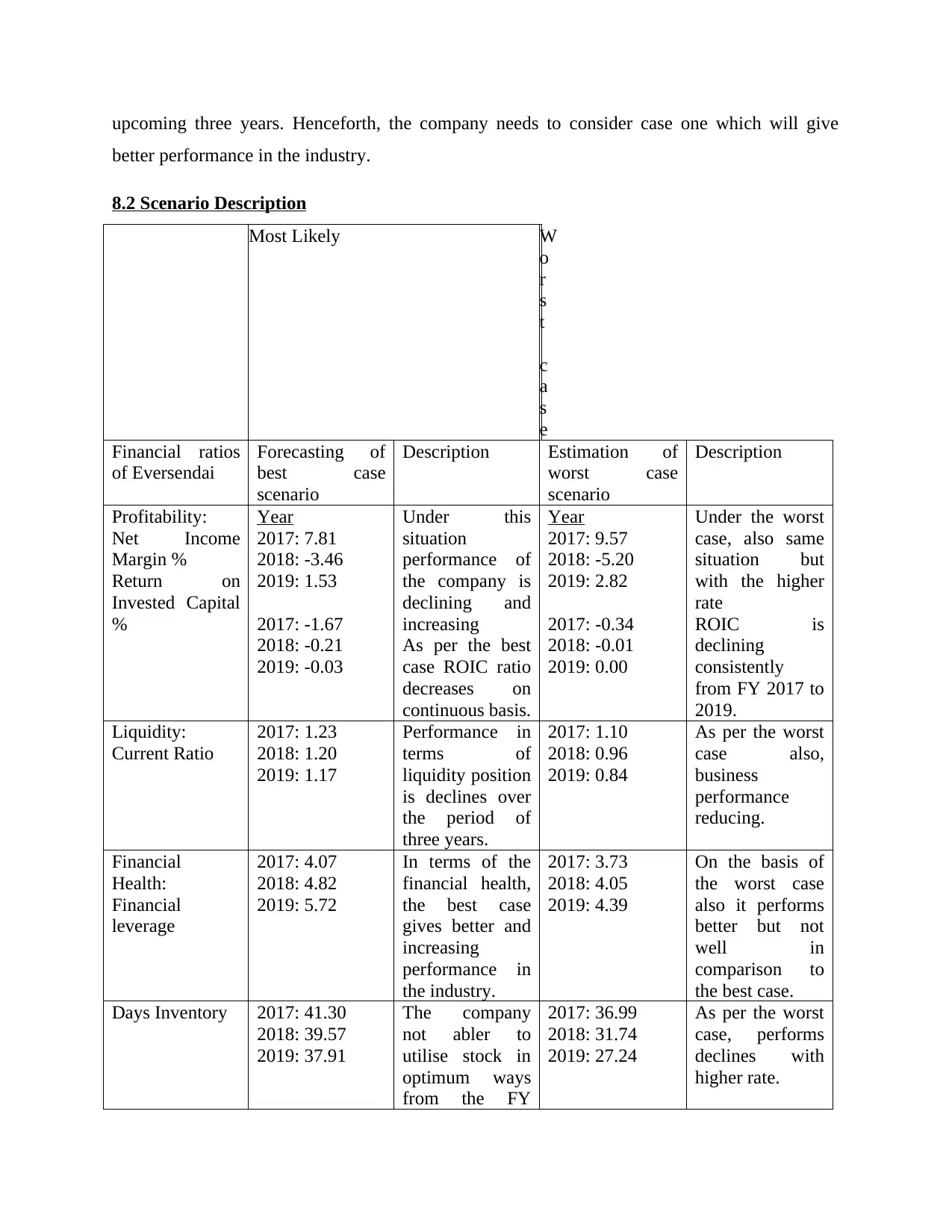
upcoming three years. Henceforth, the company needs to consider case one which will give
better performance in the industry.
8.2 Scenario Description
Most Likely W
o
r
s
t
c
a
s
e
Financial ratios
of Eversendai
Forecasting of
best case
scenario
Description Estimation of
worst case
scenario
Description
Profitability:
Net Income
Margin %
Return on
Invested Capital
%
Year
2017: 7.81
2018: -3.46
2019: 1.53
2017: -1.67
2018: -0.21
2019: -0.03
Under this
situation
performance of
the company is
declining and
increasing
As per the best
case ROIC ratio
decreases on
continuous basis.
Year
2017: 9.57
2018: -5.20
2019: 2.82
2017: -0.34
2018: -0.01
2019: 0.00
Under the worst
case, also same
situation but
with the higher
rate
ROIC is
declining
consistently
from FY 2017 to
2019.
Liquidity:
Current Ratio
2017: 1.23
2018: 1.20
2019: 1.17
Performance in
terms of
liquidity position
is declines over
the period of
three years.
2017: 1.10
2018: 0.96
2019: 0.84
As per the worst
case also,
business
performance
reducing.
Financial
Health:
Financial
leverage
2017: 4.07
2018: 4.82
2019: 5.72
In terms of the
financial health,
the best case
gives better and
increasing
performance in
the industry.
2017: 3.73
2018: 4.05
2019: 4.39
On the basis of
the worst case
also it performs
better but not
well in
comparison to
the best case.
Days Inventory 2017: 41.30
2018: 39.57
2019: 37.91
The company
not abler to
utilise stock in
optimum ways
from the FY
2017: 36.99
2018: 31.74
2019: 27.24
As per the worst
case, performs
declines with
higher rate.
better performance in the industry.
8.2 Scenario Description
Most Likely W
o
r
s
t
c
a
s
e
Financial ratios
of Eversendai
Forecasting of
best case
scenario
Description Estimation of
worst case
scenario
Description
Profitability:
Net Income
Margin %
Return on
Invested Capital
%
Year
2017: 7.81
2018: -3.46
2019: 1.53
2017: -1.67
2018: -0.21
2019: -0.03
Under this
situation
performance of
the company is
declining and
increasing
As per the best
case ROIC ratio
decreases on
continuous basis.
Year
2017: 9.57
2018: -5.20
2019: 2.82
2017: -0.34
2018: -0.01
2019: 0.00
Under the worst
case, also same
situation but
with the higher
rate
ROIC is
declining
consistently
from FY 2017 to
2019.
Liquidity:
Current Ratio
2017: 1.23
2018: 1.20
2019: 1.17
Performance in
terms of
liquidity position
is declines over
the period of
three years.
2017: 1.10
2018: 0.96
2019: 0.84
As per the worst
case also,
business
performance
reducing.
Financial
Health:
Financial
leverage
2017: 4.07
2018: 4.82
2019: 5.72
In terms of the
financial health,
the best case
gives better and
increasing
performance in
the industry.
2017: 3.73
2018: 4.05
2019: 4.39
On the basis of
the worst case
also it performs
better but not
well in
comparison to
the best case.
Days Inventory 2017: 41.30
2018: 39.57
2019: 37.91
The company
not abler to
utilise stock in
optimum ways
from the FY
2017: 36.99
2018: 31.74
2019: 27.24
As per the worst
case, performs
declines with
higher rate.
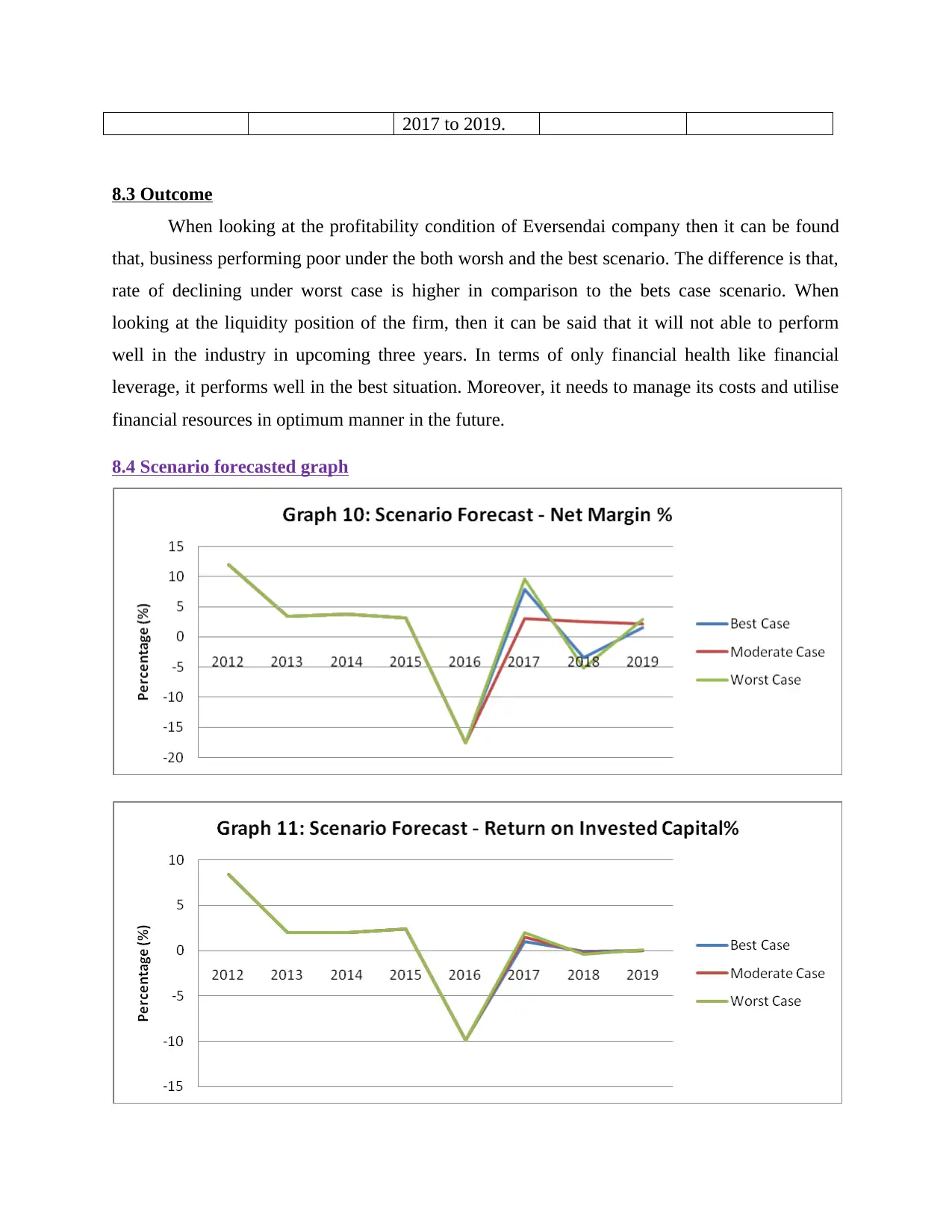
2017 to 2019.
8.3 Outcome
When looking at the profitability condition of Eversendai company then it can be found
that, business performing poor under the both worsh and the best scenario. The difference is that,
rate of declining under worst case is higher in comparison to the bets case scenario. When
looking at the liquidity position of the firm, then it can be said that it will not able to perform
well in the industry in upcoming three years. In terms of only financial health like financial
leverage, it performs well in the best situation. Moreover, it needs to manage its costs and utilise
financial resources in optimum manner in the future.
8.4 Scenario forecasted graph
8.3 Outcome
When looking at the profitability condition of Eversendai company then it can be found
that, business performing poor under the both worsh and the best scenario. The difference is that,
rate of declining under worst case is higher in comparison to the bets case scenario. When
looking at the liquidity position of the firm, then it can be said that it will not able to perform
well in the industry in upcoming three years. In terms of only financial health like financial
leverage, it performs well in the best situation. Moreover, it needs to manage its costs and utilise
financial resources in optimum manner in the future.
8.4 Scenario forecasted graph
Paraphrase This Document
Need a fresh take? Get an instant paraphrase of this document with our AI Paraphraser
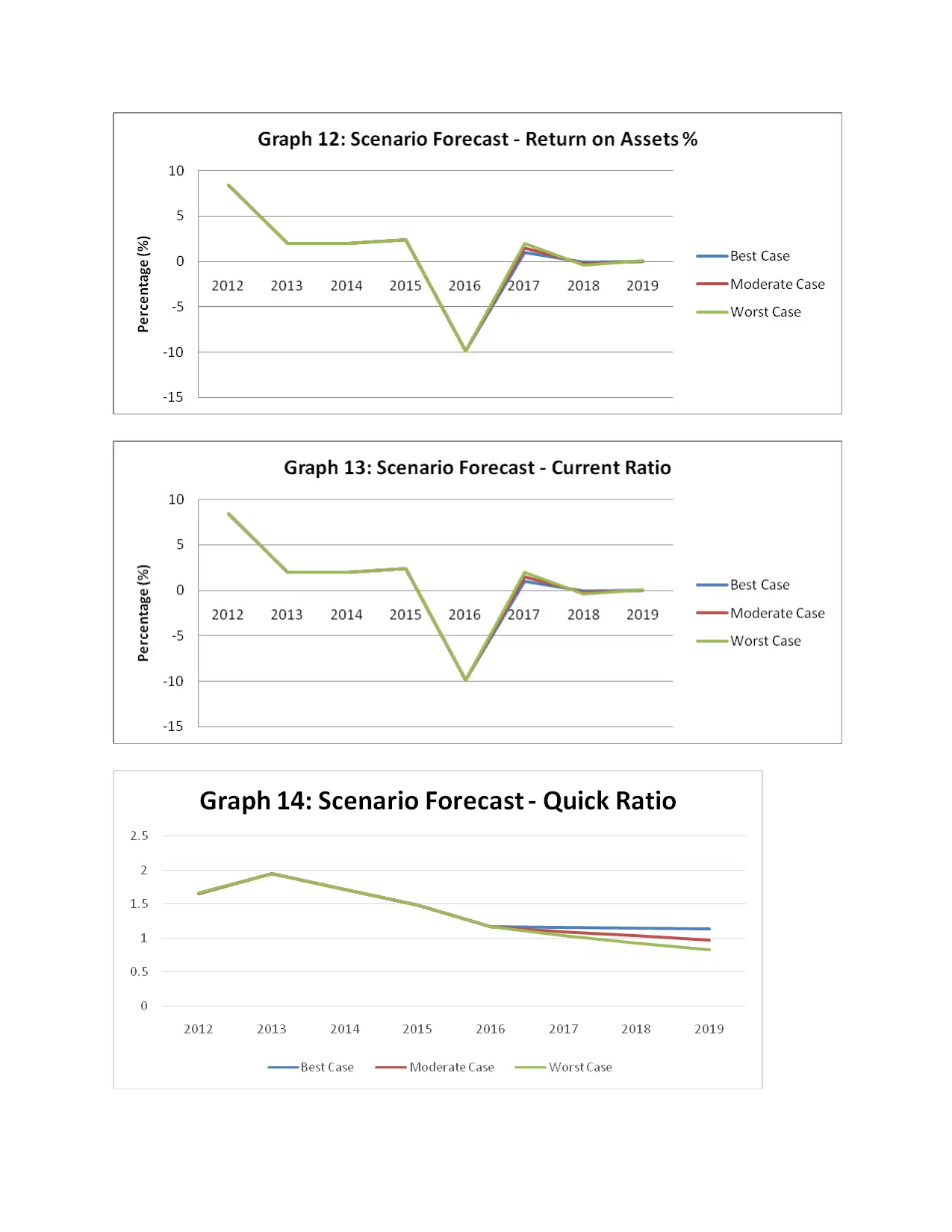
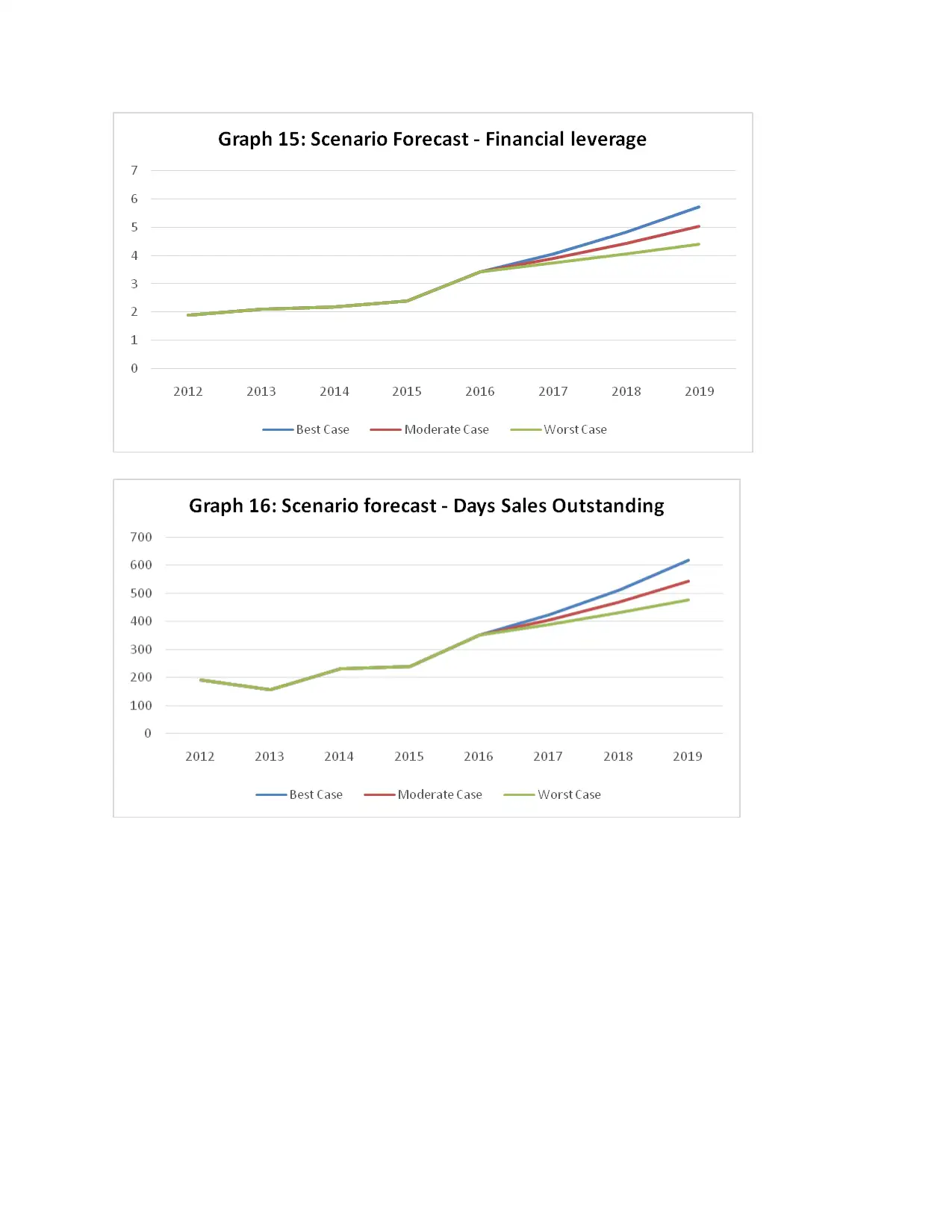
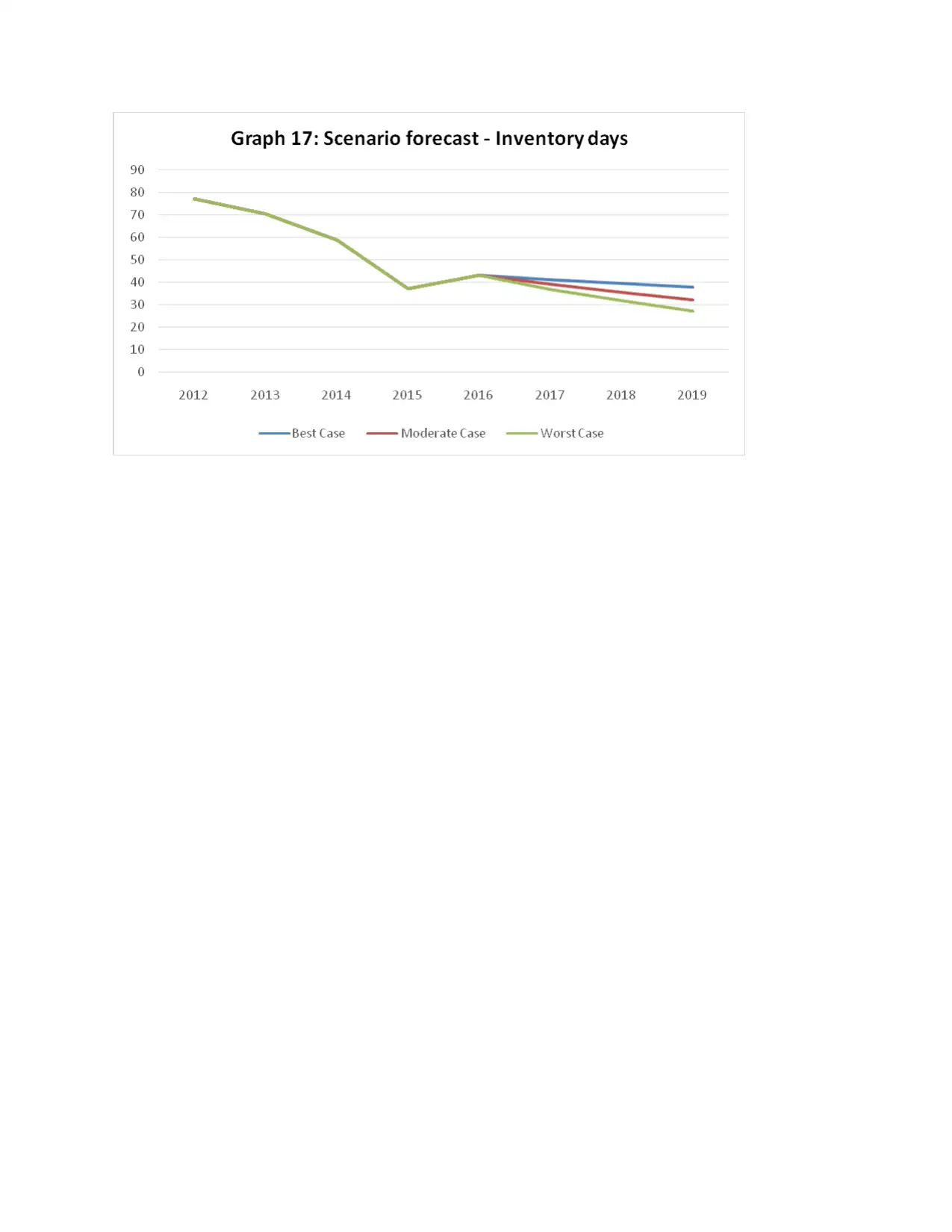
Secure Best Marks with AI Grader
Need help grading? Try our AI Grader for instant feedback on your assignments.

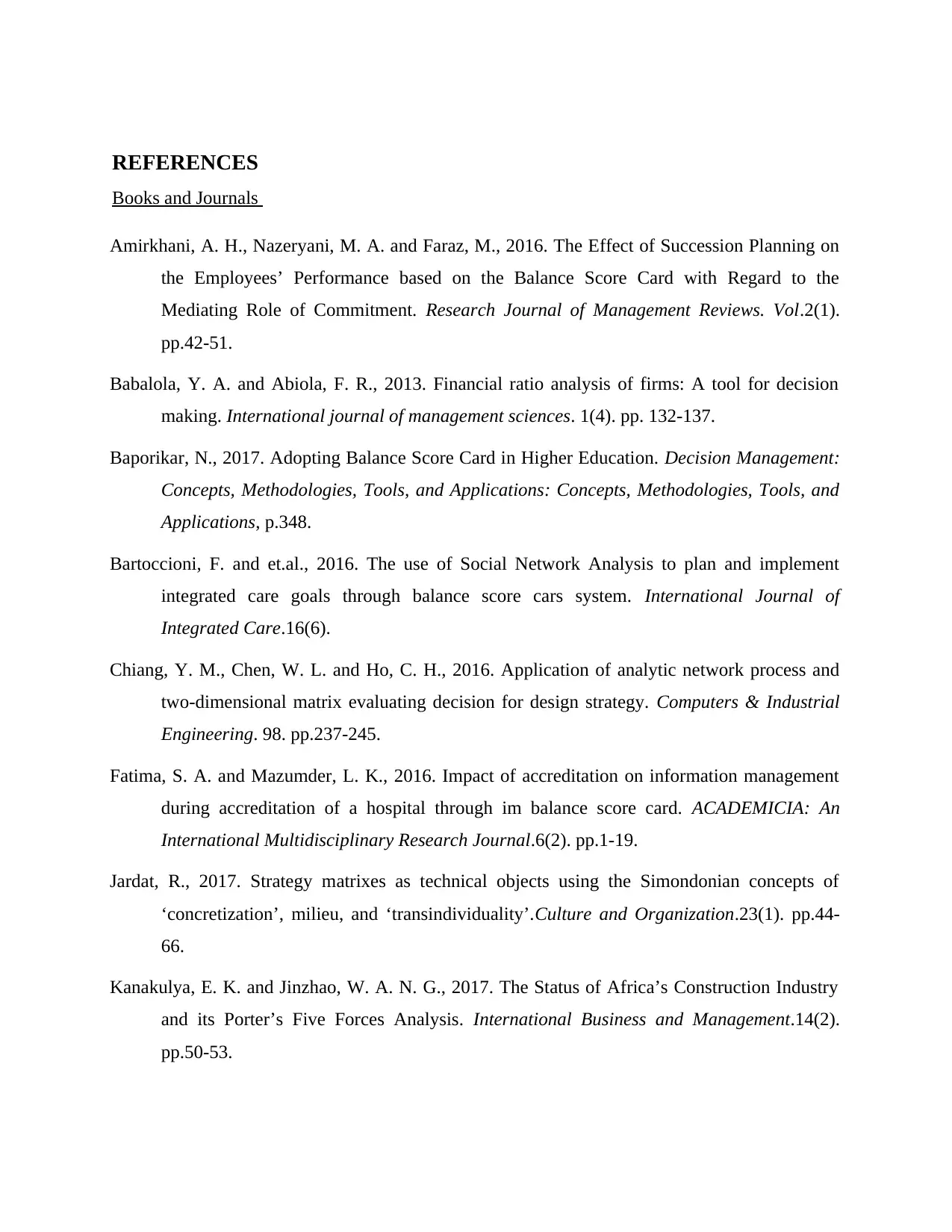
REFERENCES
Books and Journals
Amirkhani, A. H., Nazeryani, M. A. and Faraz, M., 2016. The Effect of Succession Planning on
the Employees’ Performance based on the Balance Score Card with Regard to the
Mediating Role of Commitment. Research Journal of Management Reviews. Vol.2(1).
pp.42-51.
Babalola, Y. A. and Abiola, F. R., 2013. Financial ratio analysis of firms: A tool for decision
making. International journal of management sciences. 1(4). pp. 132-137.
Baporikar, N., 2017. Adopting Balance Score Card in Higher Education. Decision Management:
Concepts, Methodologies, Tools, and Applications: Concepts, Methodologies, Tools, and
Applications, p.348.
Bartoccioni, F. and et.al., 2016. The use of Social Network Analysis to plan and implement
integrated care goals through balance score cars system. International Journal of
Integrated Care.16(6).
Chiang, Y. M., Chen, W. L. and Ho, C. H., 2016. Application of analytic network process and
two-dimensional matrix evaluating decision for design strategy. Computers & Industrial
Engineering. 98. pp.237-245.
Fatima, S. A. and Mazumder, L. K., 2016. Impact of accreditation on information management
during accreditation of a hospital through im balance score card. ACADEMICIA: An
International Multidisciplinary Research Journal.6(2). pp.1-19.
Jardat, R., 2017. Strategy matrixes as technical objects using the Simondonian concepts of
‘concretization’, milieu, and ‘transindividuality’.Culture and Organization.23(1). pp.44-
66.
Kanakulya, E. K. and Jinzhao, W. A. N. G., 2017. The Status of Africa’s Construction Industry
and its Porter’s Five Forces Analysis. International Business and Management.14(2).
pp.50-53.
Books and Journals
Amirkhani, A. H., Nazeryani, M. A. and Faraz, M., 2016. The Effect of Succession Planning on
the Employees’ Performance based on the Balance Score Card with Regard to the
Mediating Role of Commitment. Research Journal of Management Reviews. Vol.2(1).
pp.42-51.
Babalola, Y. A. and Abiola, F. R., 2013. Financial ratio analysis of firms: A tool for decision
making. International journal of management sciences. 1(4). pp. 132-137.
Baporikar, N., 2017. Adopting Balance Score Card in Higher Education. Decision Management:
Concepts, Methodologies, Tools, and Applications: Concepts, Methodologies, Tools, and
Applications, p.348.
Bartoccioni, F. and et.al., 2016. The use of Social Network Analysis to plan and implement
integrated care goals through balance score cars system. International Journal of
Integrated Care.16(6).
Chiang, Y. M., Chen, W. L. and Ho, C. H., 2016. Application of analytic network process and
two-dimensional matrix evaluating decision for design strategy. Computers & Industrial
Engineering. 98. pp.237-245.
Fatima, S. A. and Mazumder, L. K., 2016. Impact of accreditation on information management
during accreditation of a hospital through im balance score card. ACADEMICIA: An
International Multidisciplinary Research Journal.6(2). pp.1-19.
Jardat, R., 2017. Strategy matrixes as technical objects using the Simondonian concepts of
‘concretization’, milieu, and ‘transindividuality’.Culture and Organization.23(1). pp.44-
66.
Kanakulya, E. K. and Jinzhao, W. A. N. G., 2017. The Status of Africa’s Construction Industry
and its Porter’s Five Forces Analysis. International Business and Management.14(2).
pp.50-53.
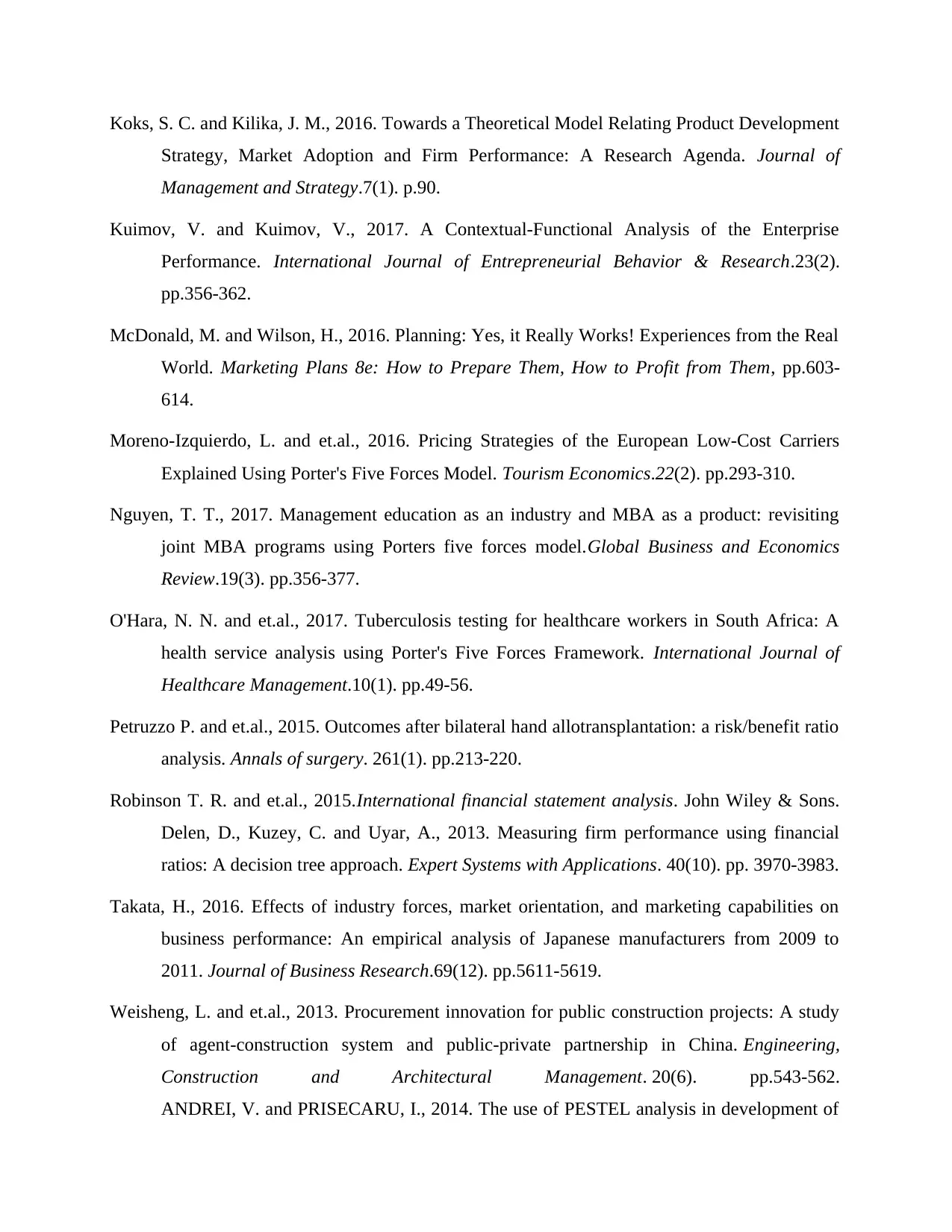
Koks, S. C. and Kilika, J. M., 2016. Towards a Theoretical Model Relating Product Development
Strategy, Market Adoption and Firm Performance: A Research Agenda. Journal of
Management and Strategy.7(1). p.90.
Kuimov, V. and Kuimov, V., 2017. A Contextual-Functional Analysis of the Enterprise
Performance. International Journal of Entrepreneurial Behavior & Research.23(2).
pp.356-362.
McDonald, M. and Wilson, H., 2016. Planning: Yes, it Really Works! Experiences from the Real
World. Marketing Plans 8e: How to Prepare Them, How to Profit from Them, pp.603-
614.
Moreno-Izquierdo, L. and et.al., 2016. Pricing Strategies of the European Low-Cost Carriers
Explained Using Porter's Five Forces Model. Tourism Economics.22(2). pp.293-310.
Nguyen, T. T., 2017. Management education as an industry and MBA as a product: revisiting
joint MBA programs using Porters five forces model.Global Business and Economics
Review.19(3). pp.356-377.
O'Hara, N. N. and et.al., 2017. Tuberculosis testing for healthcare workers in South Africa: A
health service analysis using Porter's Five Forces Framework. International Journal of
Healthcare Management.10(1). pp.49-56.
Petruzzo P. and et.al., 2015. Outcomes after bilateral hand allotransplantation: a risk/benefit ratio
analysis. Annals of surgery. 261(1). pp.213-220.
Robinson T. R. and et.al., 2015.International financial statement analysis. John Wiley & Sons.
Delen, D., Kuzey, C. and Uyar, A., 2013. Measuring firm performance using financial
ratios: A decision tree approach. Expert Systems with Applications. 40(10). pp. 3970-3983.
Takata, H., 2016. Effects of industry forces, market orientation, and marketing capabilities on
business performance: An empirical analysis of Japanese manufacturers from 2009 to
2011. Journal of Business Research.69(12). pp.5611-5619.
Weisheng, L. and et.al., 2013. Procurement innovation for public construction projects: A study
of agent-construction system and public-private partnership in China. Engineering,
Construction and Architectural Management. 20(6). pp.543-562.
ANDREI, V. and PRISECARU, I., 2014. The use of PESTEL analysis in development of
Strategy, Market Adoption and Firm Performance: A Research Agenda. Journal of
Management and Strategy.7(1). p.90.
Kuimov, V. and Kuimov, V., 2017. A Contextual-Functional Analysis of the Enterprise
Performance. International Journal of Entrepreneurial Behavior & Research.23(2).
pp.356-362.
McDonald, M. and Wilson, H., 2016. Planning: Yes, it Really Works! Experiences from the Real
World. Marketing Plans 8e: How to Prepare Them, How to Profit from Them, pp.603-
614.
Moreno-Izquierdo, L. and et.al., 2016. Pricing Strategies of the European Low-Cost Carriers
Explained Using Porter's Five Forces Model. Tourism Economics.22(2). pp.293-310.
Nguyen, T. T., 2017. Management education as an industry and MBA as a product: revisiting
joint MBA programs using Porters five forces model.Global Business and Economics
Review.19(3). pp.356-377.
O'Hara, N. N. and et.al., 2017. Tuberculosis testing for healthcare workers in South Africa: A
health service analysis using Porter's Five Forces Framework. International Journal of
Healthcare Management.10(1). pp.49-56.
Petruzzo P. and et.al., 2015. Outcomes after bilateral hand allotransplantation: a risk/benefit ratio
analysis. Annals of surgery. 261(1). pp.213-220.
Robinson T. R. and et.al., 2015.International financial statement analysis. John Wiley & Sons.
Delen, D., Kuzey, C. and Uyar, A., 2013. Measuring firm performance using financial
ratios: A decision tree approach. Expert Systems with Applications. 40(10). pp. 3970-3983.
Takata, H., 2016. Effects of industry forces, market orientation, and marketing capabilities on
business performance: An empirical analysis of Japanese manufacturers from 2009 to
2011. Journal of Business Research.69(12). pp.5611-5619.
Weisheng, L. and et.al., 2013. Procurement innovation for public construction projects: A study
of agent-construction system and public-private partnership in China. Engineering,
Construction and Architectural Management. 20(6). pp.543-562.
ANDREI, V. and PRISECARU, I., 2014. The use of PESTEL analysis in development of
Paraphrase This Document
Need a fresh take? Get an instant paraphrase of this document with our AI Paraphraser
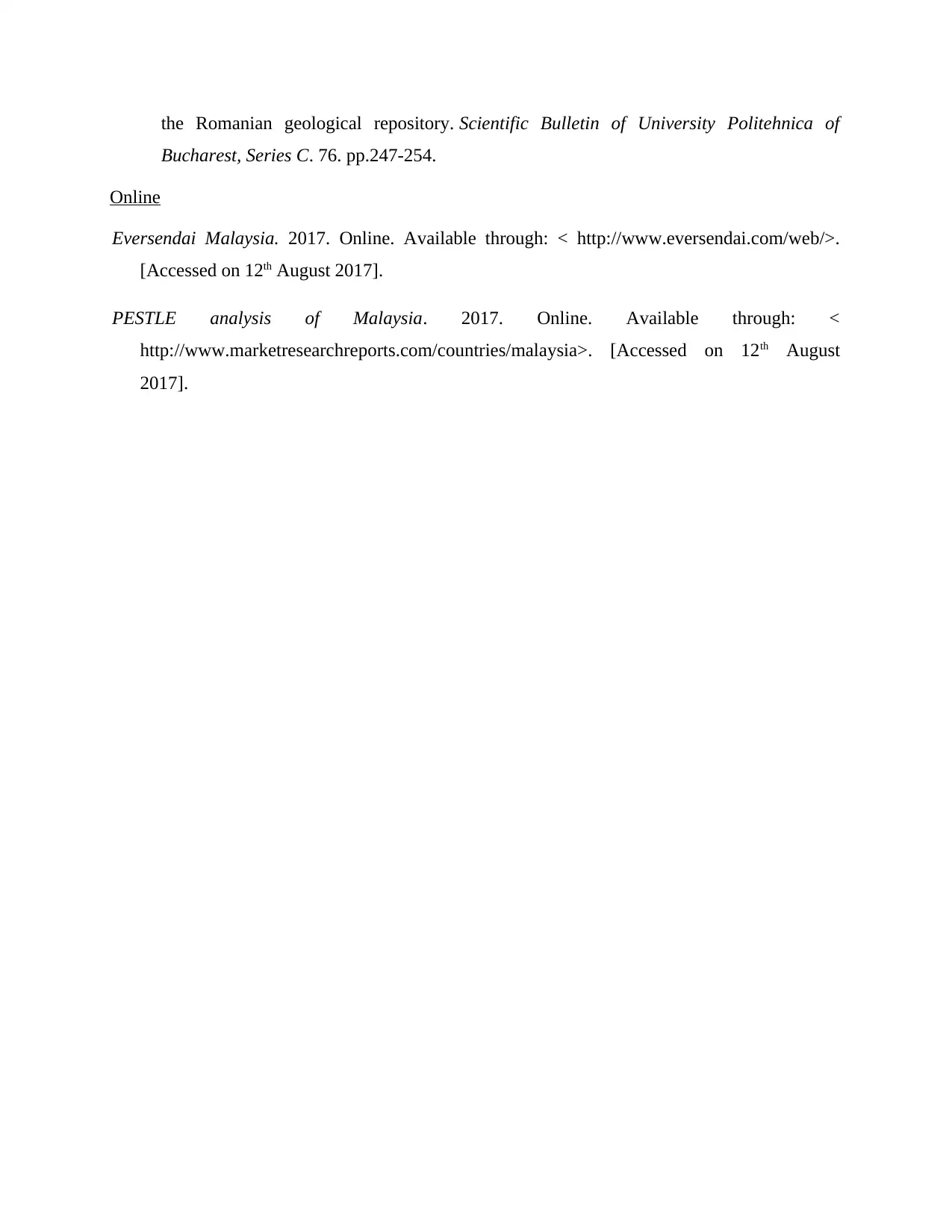
the Romanian geological repository. Scientific Bulletin of University Politehnica of
Bucharest, Series C. 76. pp.247-254.
Online
Eversendai Malaysia. 2017. Online. Available through: < http://www.eversendai.com/web/>.
[Accessed on 12th August 2017].
PESTLE analysis of Malaysia. 2017. Online. Available through: <
http://www.marketresearchreports.com/countries/malaysia>. [Accessed on 12th August
2017].
Bucharest, Series C. 76. pp.247-254.
Online
Eversendai Malaysia. 2017. Online. Available through: < http://www.eversendai.com/web/>.
[Accessed on 12th August 2017].
PESTLE analysis of Malaysia. 2017. Online. Available through: <
http://www.marketresearchreports.com/countries/malaysia>. [Accessed on 12th August
2017].
1 out of 32
Related Documents
Your All-in-One AI-Powered Toolkit for Academic Success.
+13062052269
info@desklib.com
Available 24*7 on WhatsApp / Email
![[object Object]](/_next/static/media/star-bottom.7253800d.svg)
Unlock your academic potential
© 2024 | Zucol Services PVT LTD | All rights reserved.





